Nothing quite says Kyoto better than the city’s famed Japanese rock gardens. Often referred to as Zen gardens, the rock gardens offer a scaled down version of a landscape, through carefully composed arrangements of rocks, water features, moss, pruned trees and gravel or sand that is artfully raked, to represent ripples in water.
Rock Gardens
Initially found in Zen Buddhist temples, over time, the concept of the peaceful meditative landscape became a design feature and even the smallest of homes, often feature tiny rock gardens, a wink at the grander rock gardens of Kyoto. There centuries of commentary about the nature and proper design for rock gardens that could fill pages, but a bit too dense for our purpose here. The specific placement of rocks, the placement of trees, the pattern of raking, all these features of a rock garden have deep philosophical meaning.
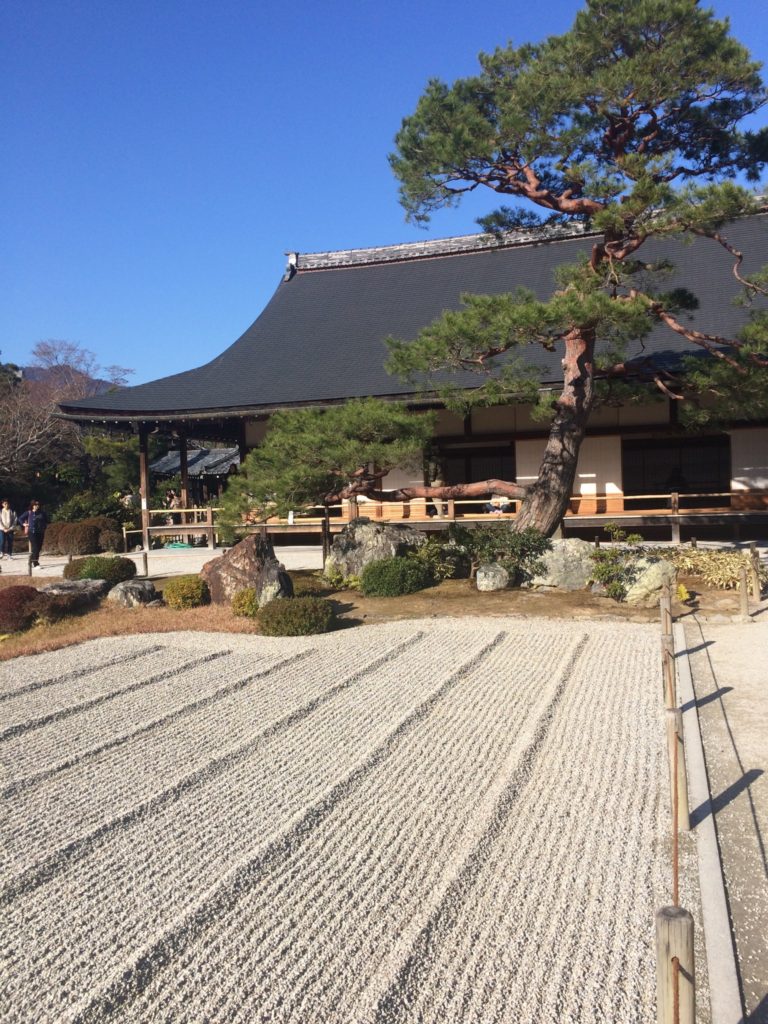
One succinct explanation given is that rock gardens were intended to replicate the intimate essence of nature and to serve as an aid to Zen meditation.
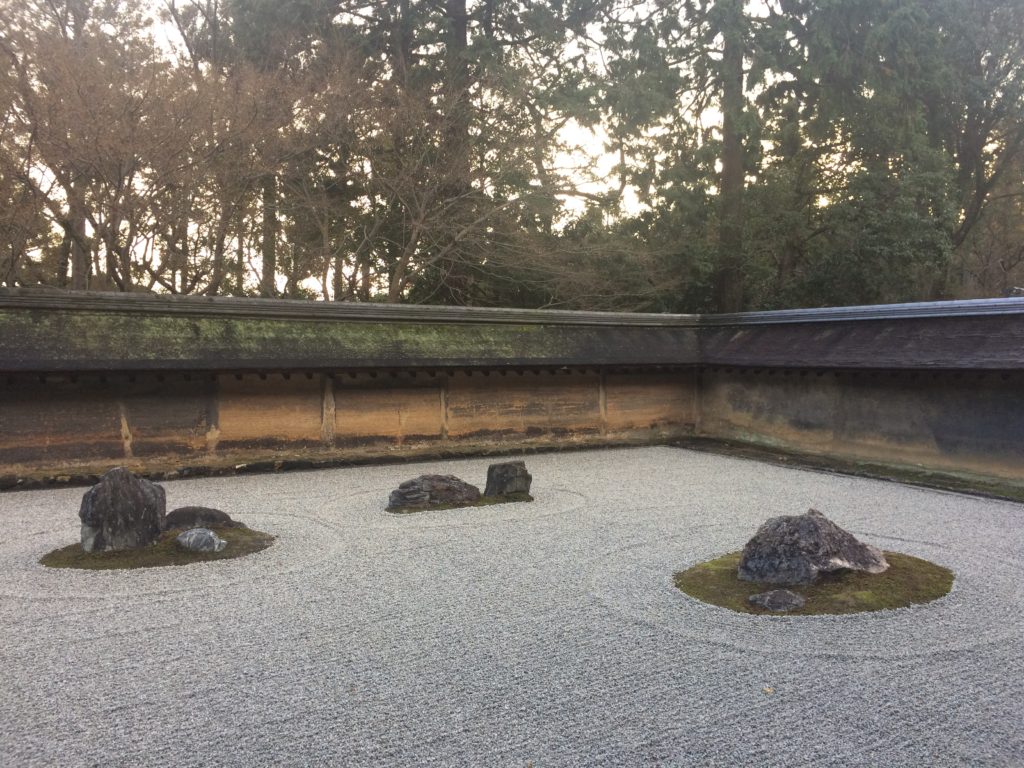
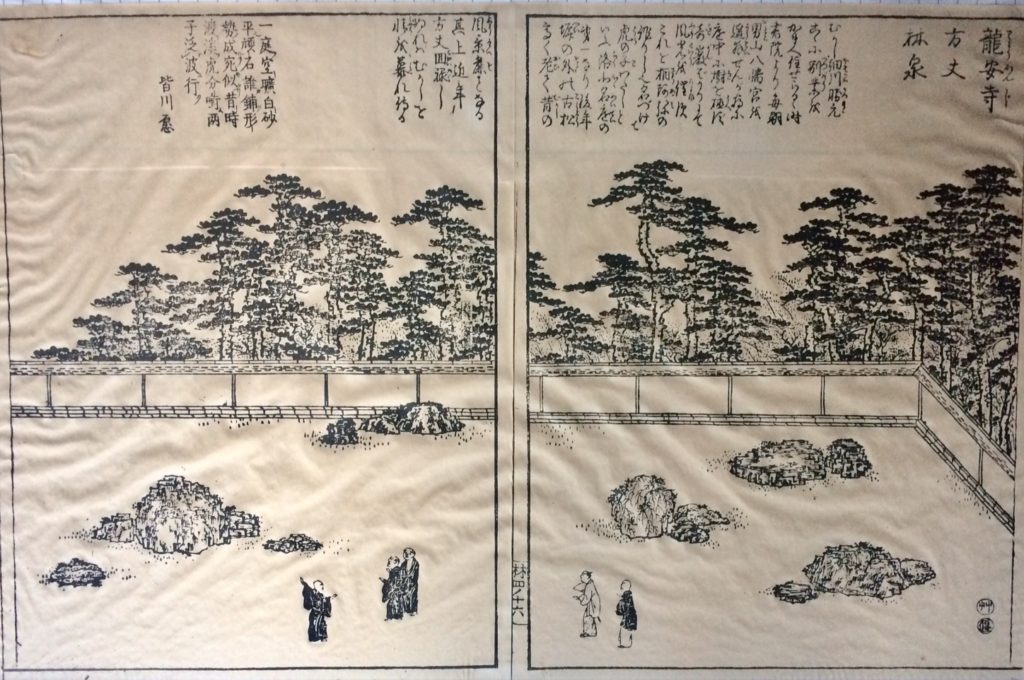
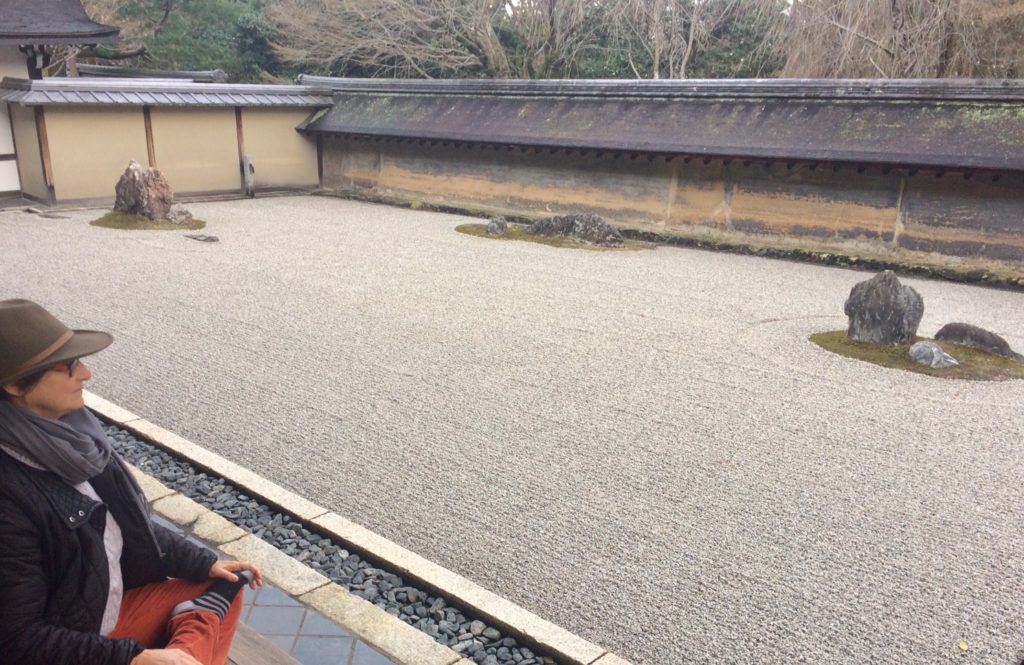
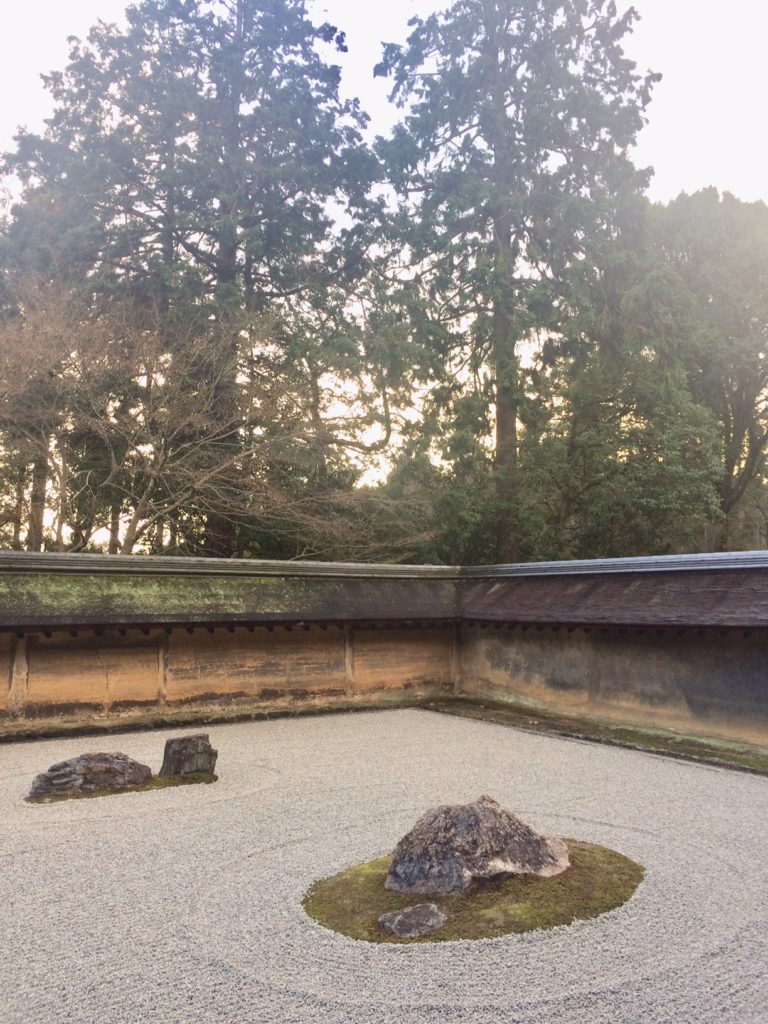
Many different theories have been put forward about what the Ryoan-ji garden is supposed to represent, from islands in a stream to swimming baby tigers to the peaks of mountains rising above the clouds to theories about secrets of geometry or of the rules of equilibrium of odd numbers.
Ryoan-ji temple itself has a heralded history, with historical references to the temple dating back to the 15th century. This temple, built around 1450 was itself built on the land of a famous Japanese warlord, head of the Fujiwara clan, who ruled this area for centuries.
All Zen gardens were designed such that they are oriented for best viewing and meditative experiences from a specific view point. These are typically large tatami-floored wooden buildings that served as an oasis of calm away from everything beyond the garden’s walls. The tatami rooms below are the viewing/meditation spot for the Ryoan Ji rock garden.
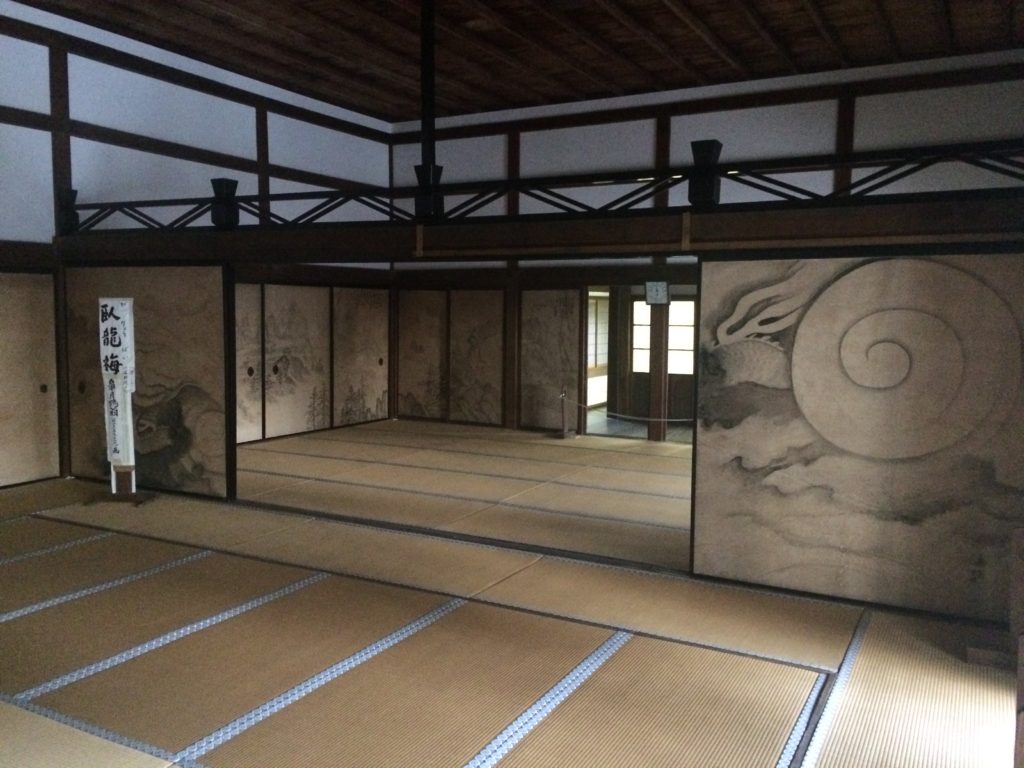
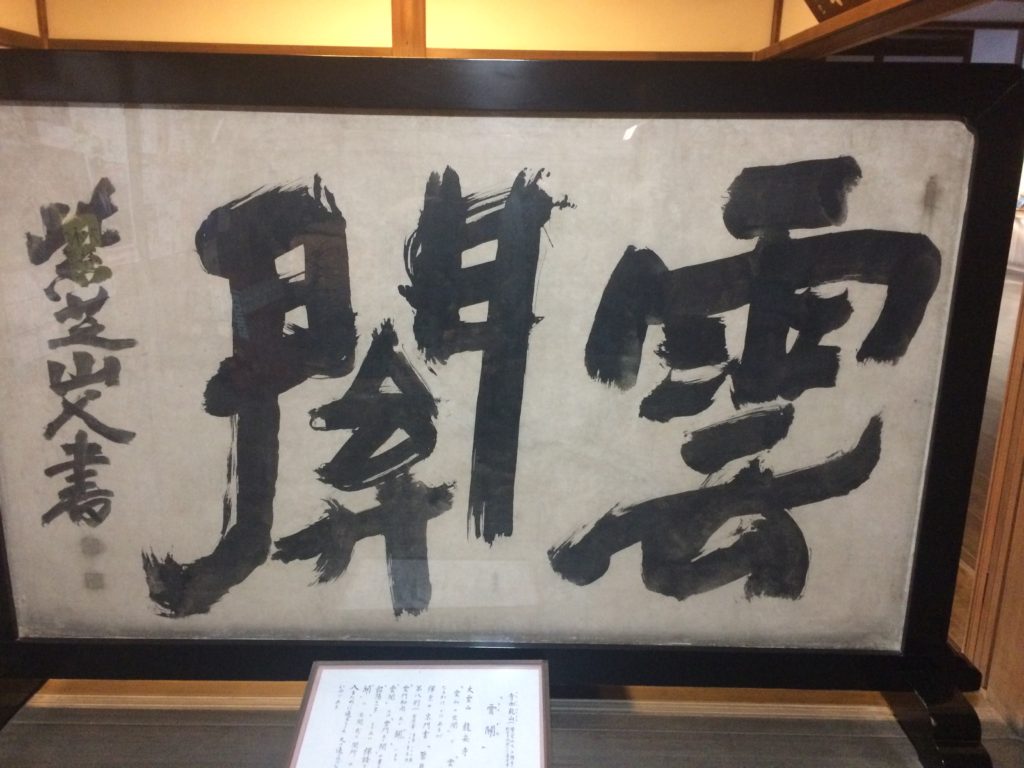
Our home exchange in Kyoto
What we are hoping for with our Kyoto home exchange is warmth. We had a grand time in Nara, but… the one downside to our home exchange accommodation there was that it was cold inside, bitterly cold.
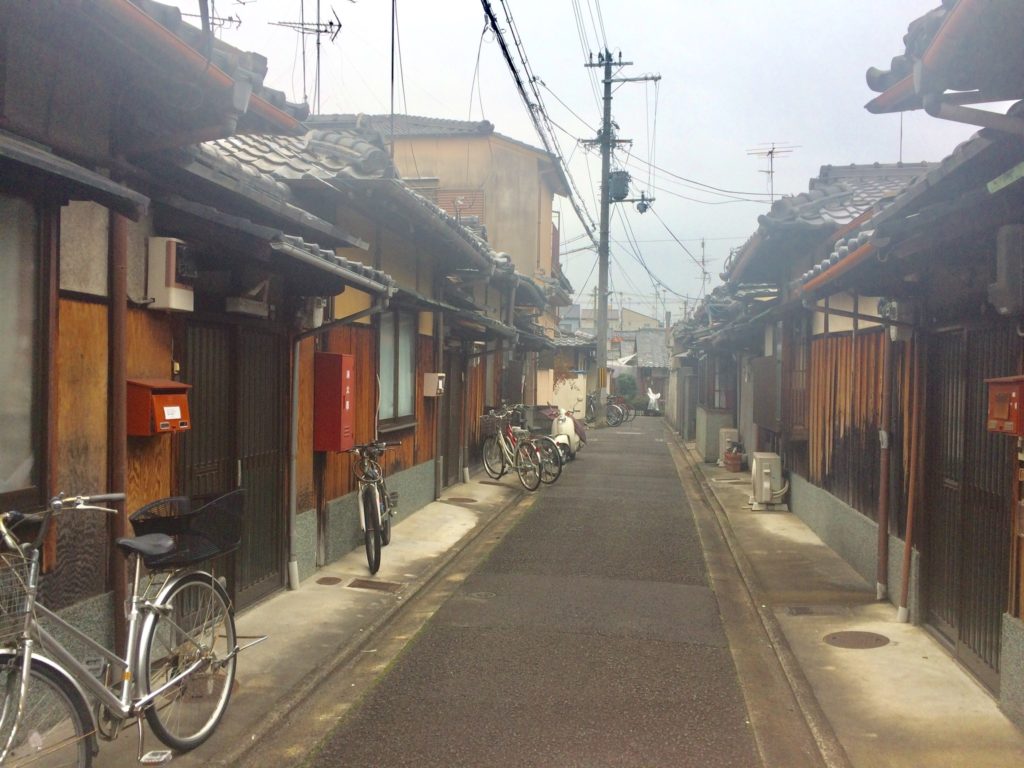
About the cold. This is our ode to the kotatsu. “What is a kotatsu?” You ask….
Kotatsu is a genius Japanese invention to stay warm on cold winter days. It consists of a low wooden table, with a large heavy piece of padded fabric, almost like a thin futon, that drops over the sides of the table, all the way to the floor. A heat source affixed to the under side of the table, heats up quickly (traditionally charcoal embers were used, but Kotatsu are now electric, for safety reasons) and the glowing heat is then trapped under the table by the futon. The operating concept is that as long as your feet and legs are warm, the rest of your body will be as well. Nothing quite like turning on the kotatsu after a long day of walking and temple hopping, and getting instantly cosy and warm.
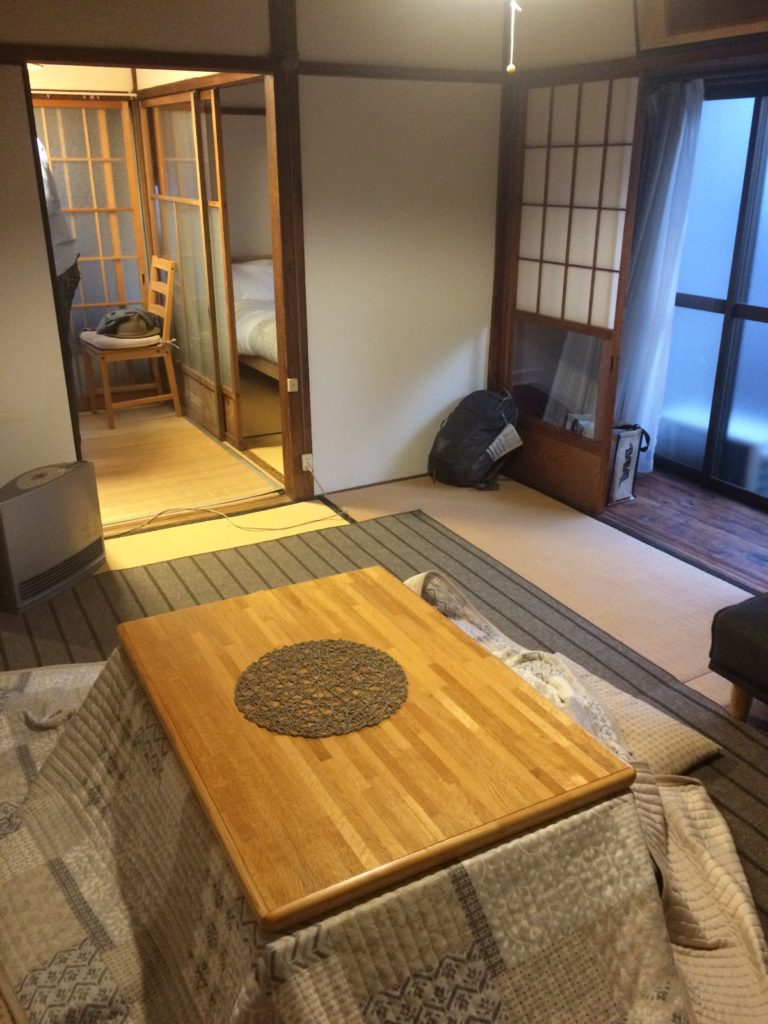
We spend hours on the floor, immediately turning the kotatsu on when we get home, after we get back from our explorations. The kotatsu combined with the tiny, but unusually deep bathtub with plenty of very hot water, are just what we need to warm up from the cold weather outside.
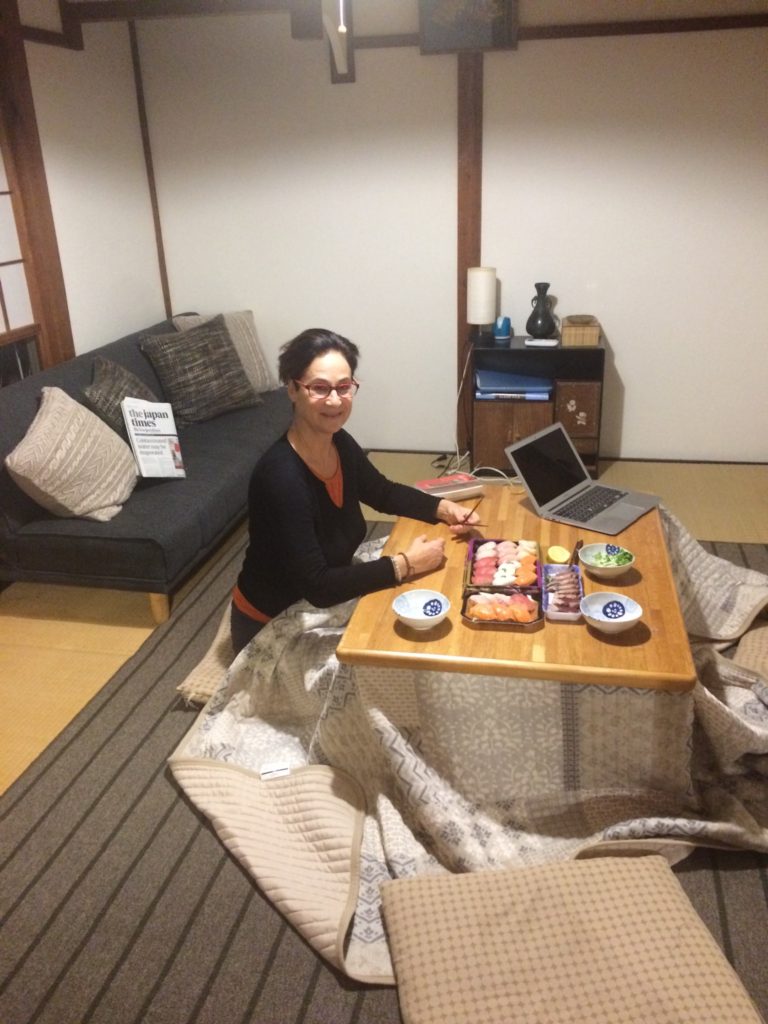

Our house is located about a twenty minute walk to the train station. We use mostly trains in order to get to the temples and gardens we want to visit, selecting one destination per day, across different locations in this relatively wide and large city of Kyoto.
The first few times we walk to the train station, there and back. After walking home at night in the cold after a long day, we decide to make use of the bicycles provided at our home exchange to bike to the station. Our train station has a huge bicycle parking garage with an easy system of checking one’s bike in and out.
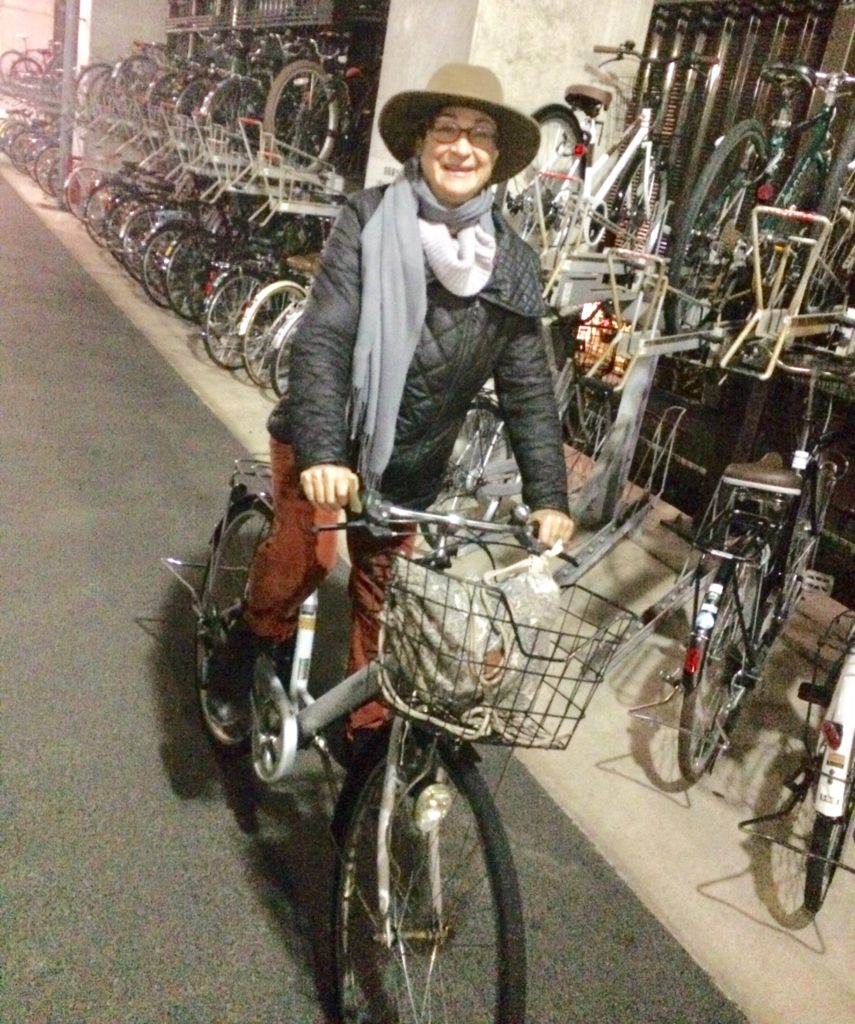
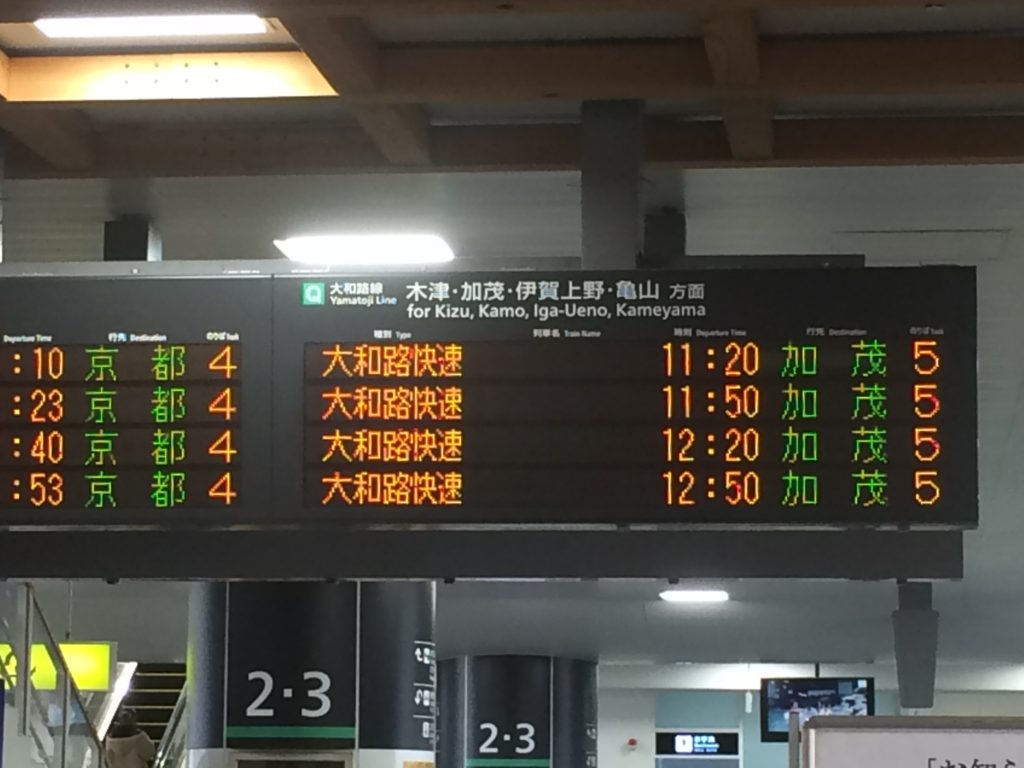
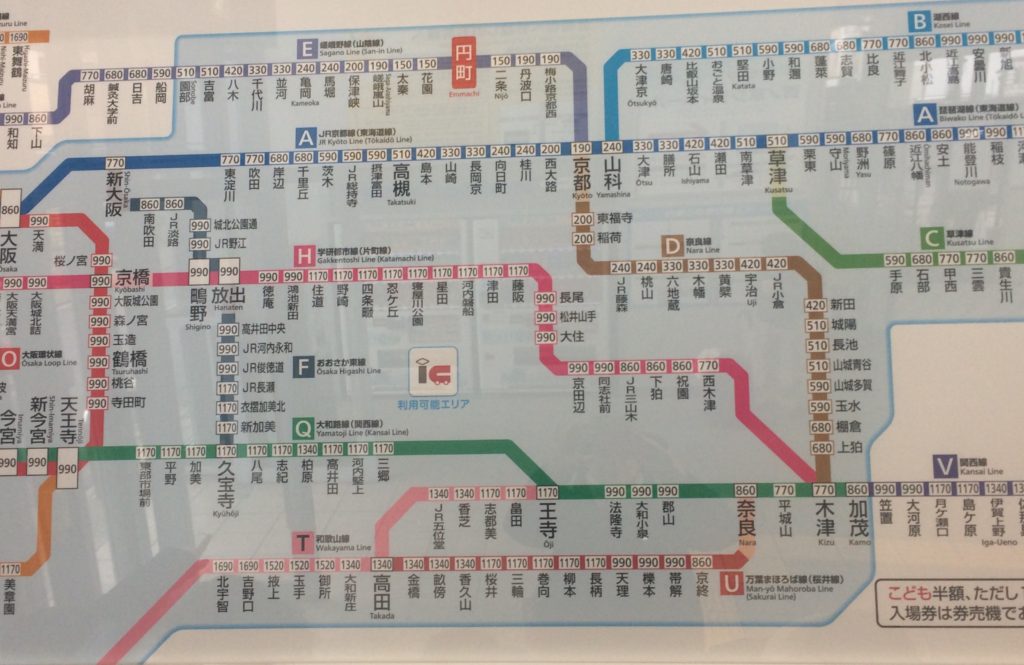
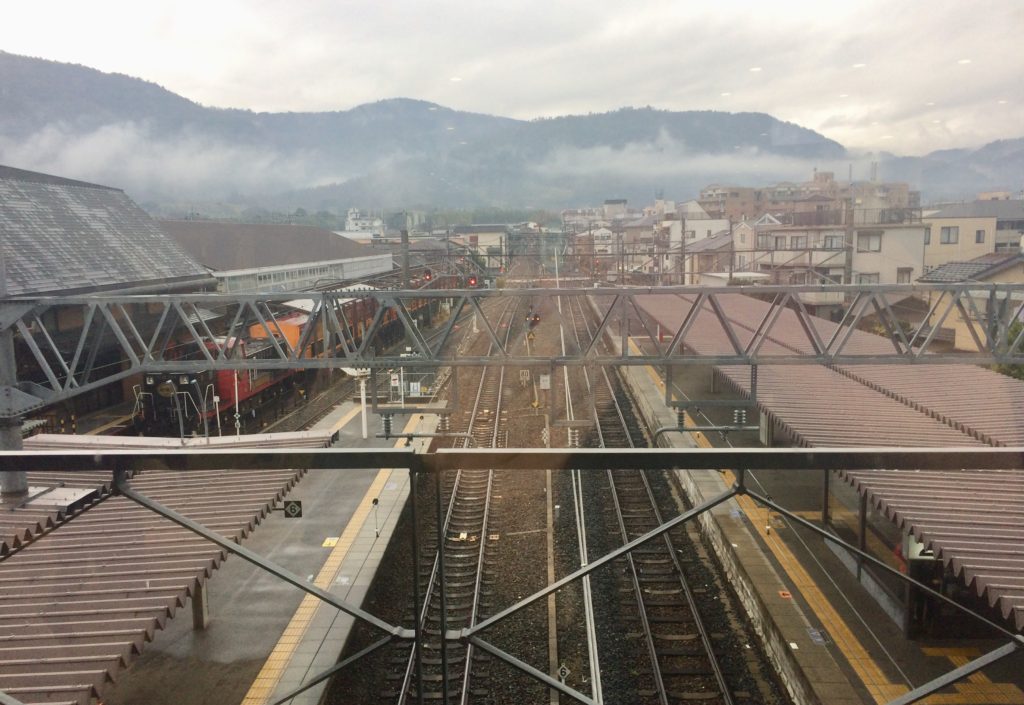
The train station at Arishayama reflects the two cultural attributes of the town ~ Its bamboo forest depicted by colorful poles of wrapped kimonos creating a kimono forest, and with a wink at Arashiyama’s hot springs with an open air hot foot bath at the platform.
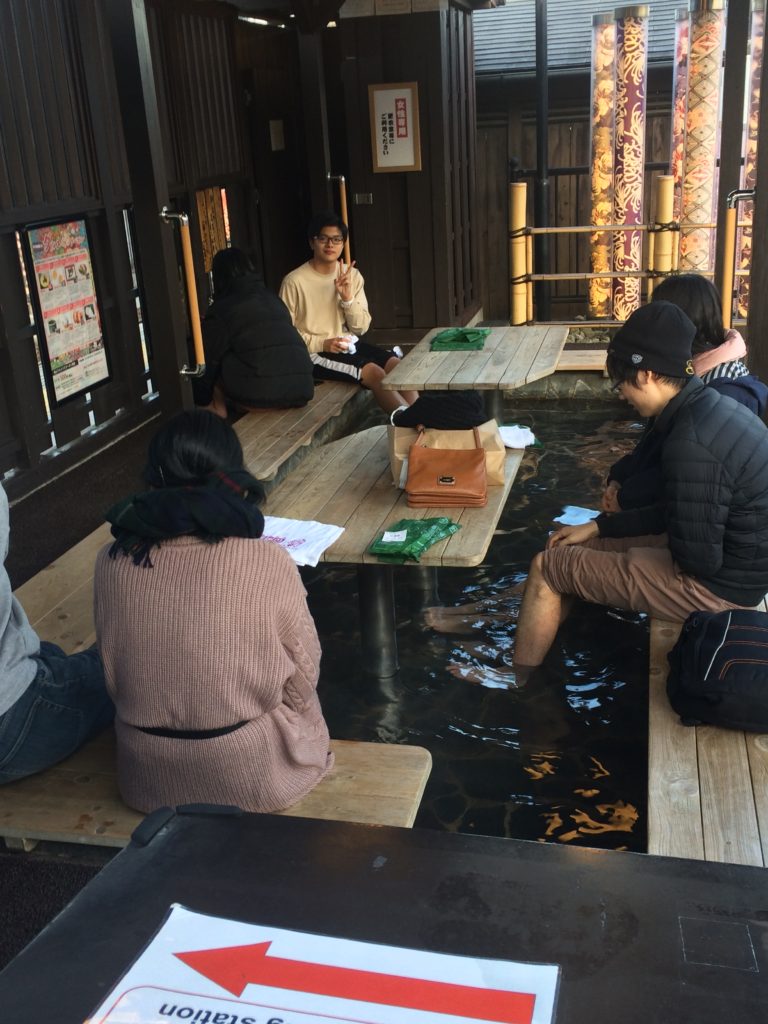
Arashiyama ~ Temples and gardens
We come to Arashiyama because we have read about the nearby bamboo forest, and given our professional (past and present) connection with bamboo, we love to discover and walk in bamboo forests along our travels.
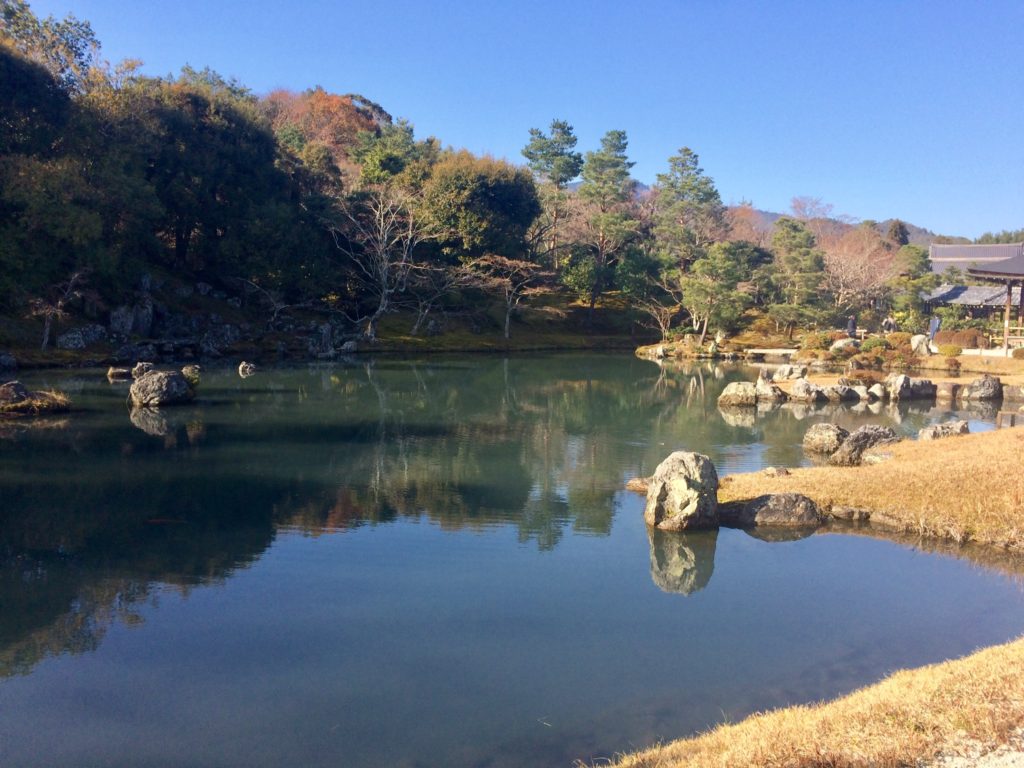
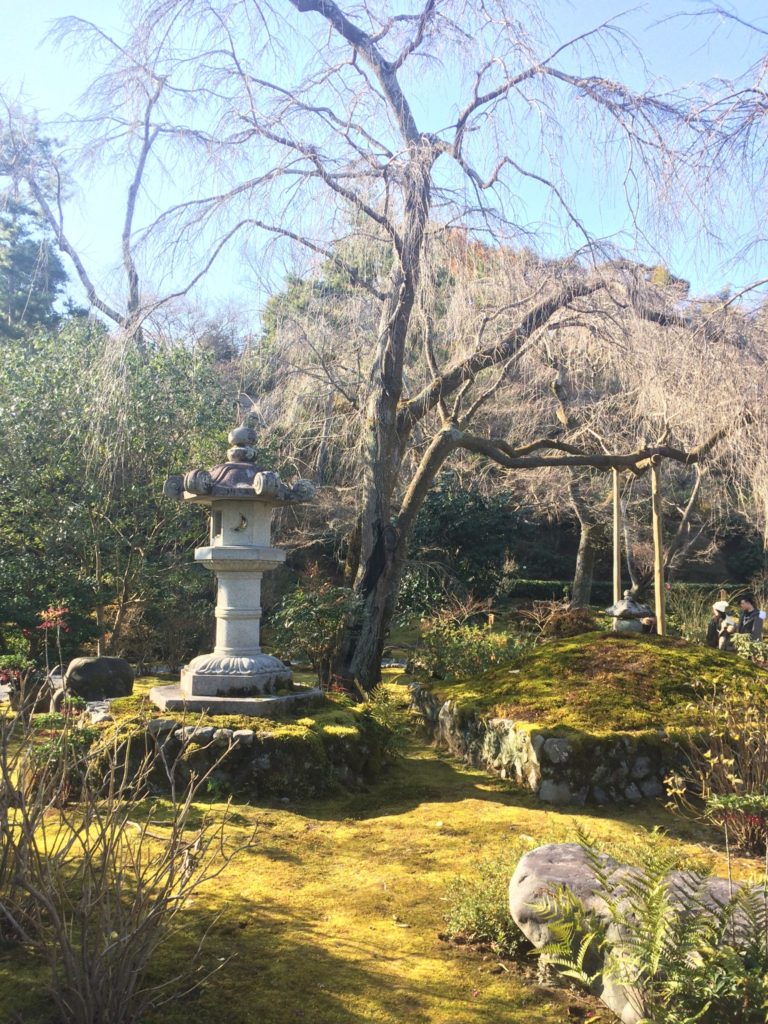
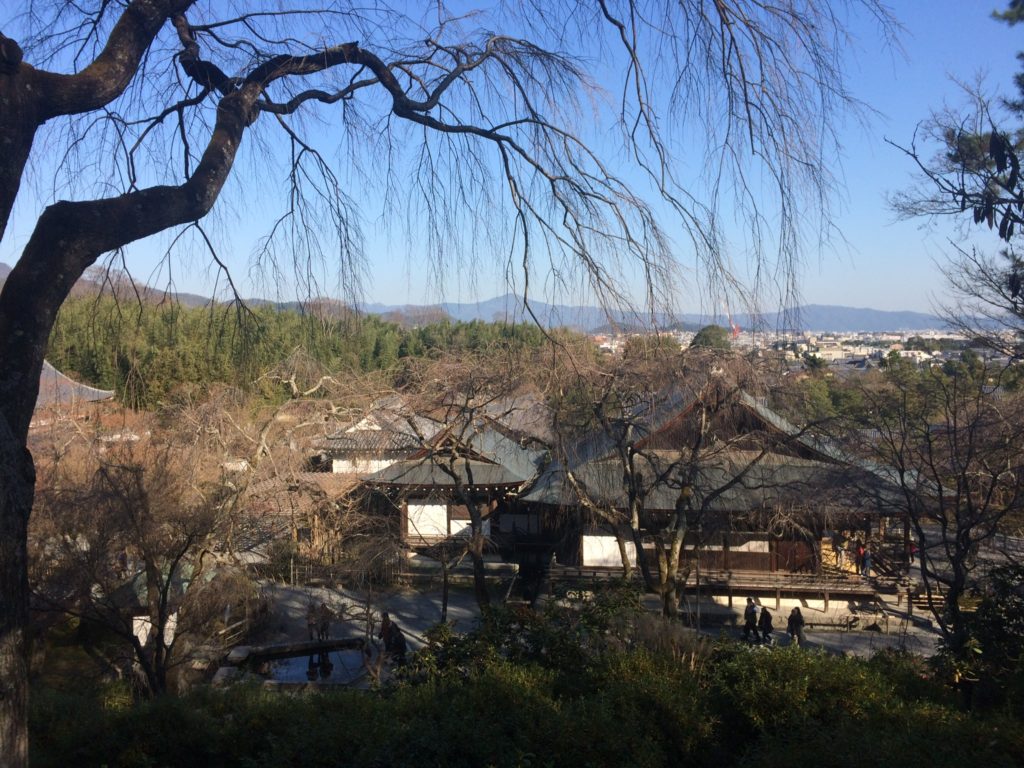
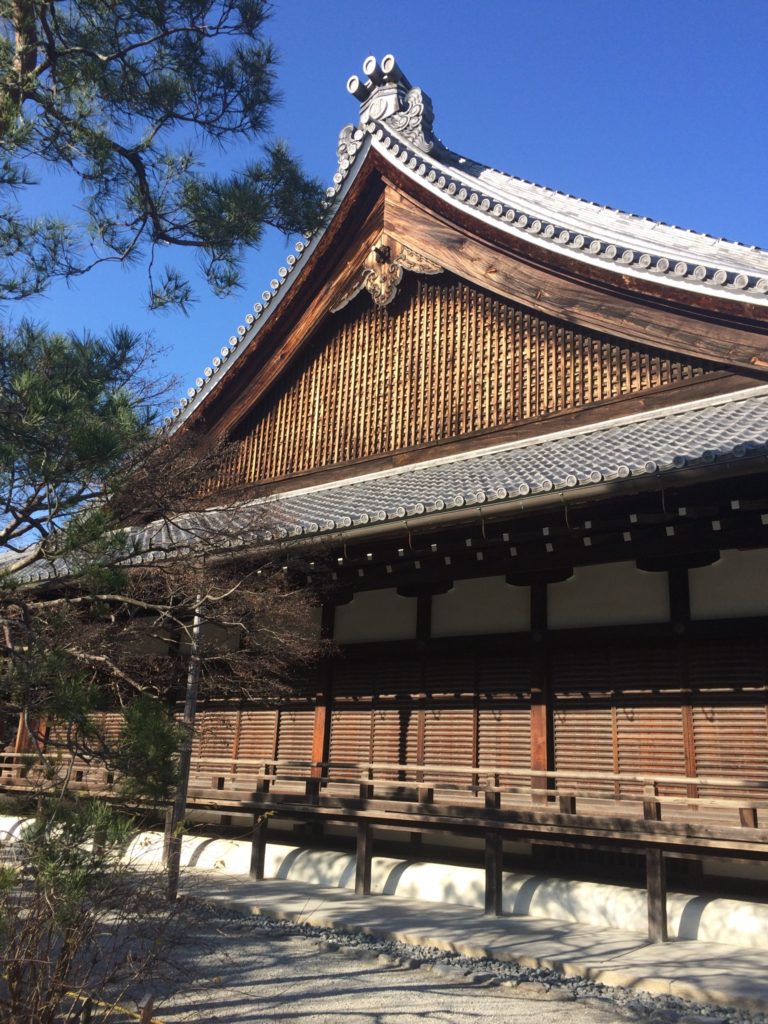
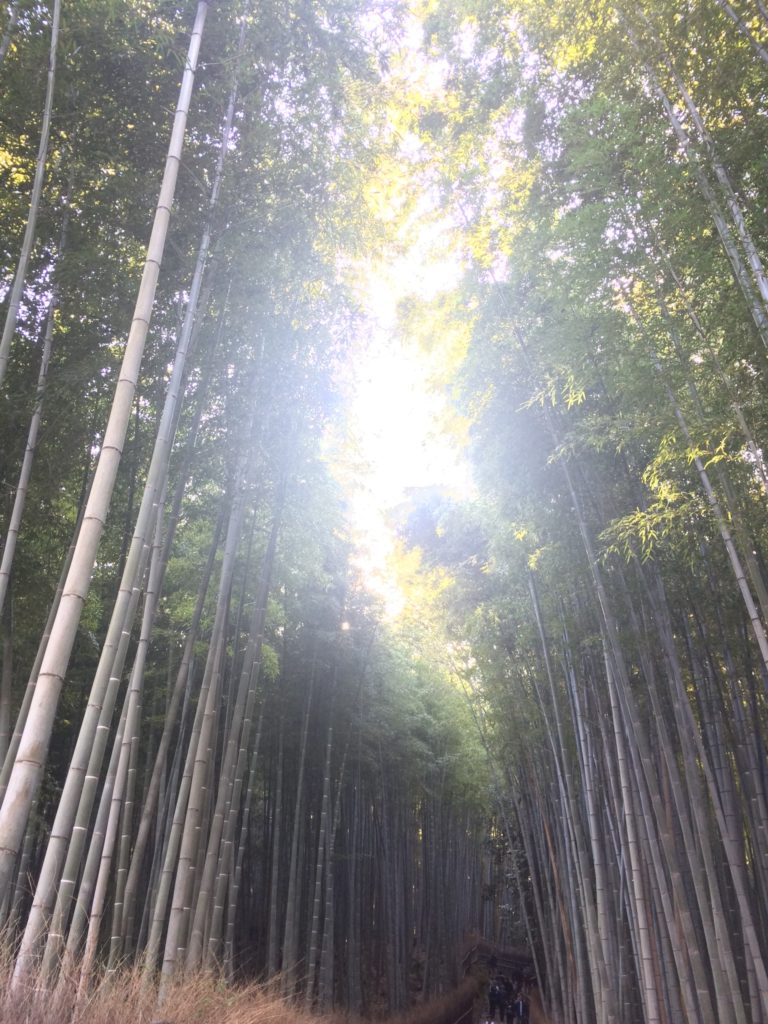
Nijo-jo Castle
Everyone has heard of Japan’s famed Samurai. In a strictly regimented Japanese society where everyone had their place, it fell upon the Samurai to defend the realm. The realm was often the territories of one family, one clan, and ultimately one shogun. The shogun was the lord of his region and for 700 years, the Samurai proved their valour on many a battlefield amongst different clans. It is at Nijo-Jo castle that this era came to an end.
The 15th and last shogun of the famed Tokugawa lineage surrendered to a new power ~ the Emperor of Japan. A residence of the Imperial family, Nijo-Jo was the site of grand Imperial presence up until 1939.
We go to the castle, primarily to see the 3,600 paper screen murals and their magnificent art work within. However, the castle is currently under restoration and there are only two rooms with art for current public viewing. We were plenty happy to see those…
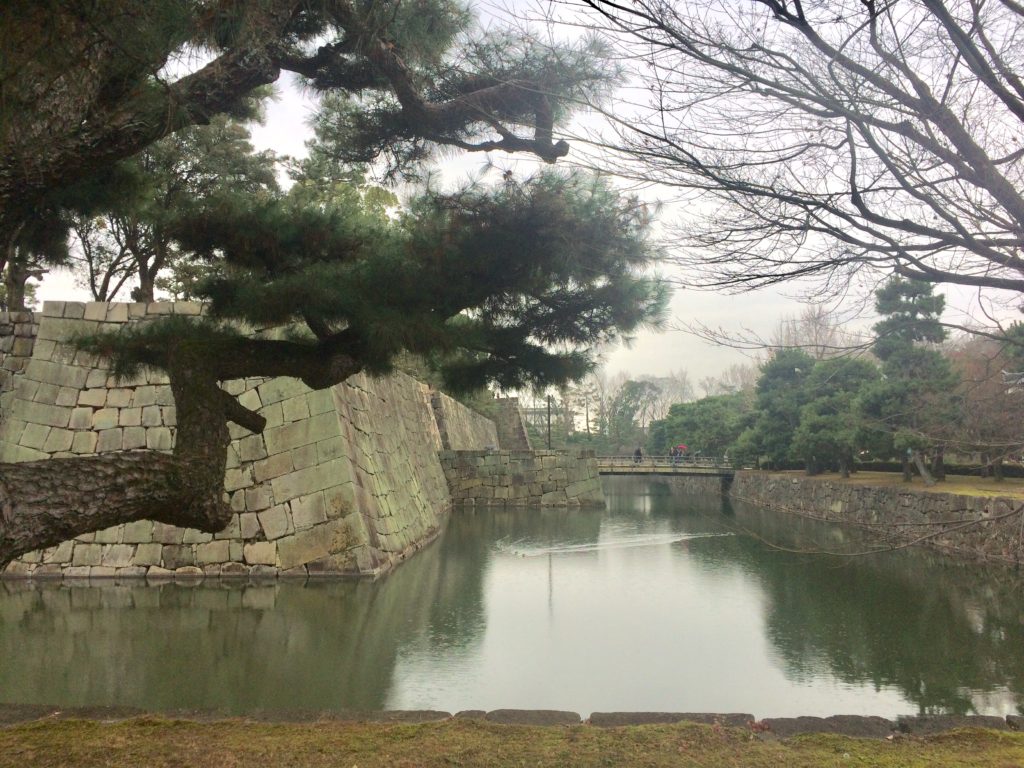
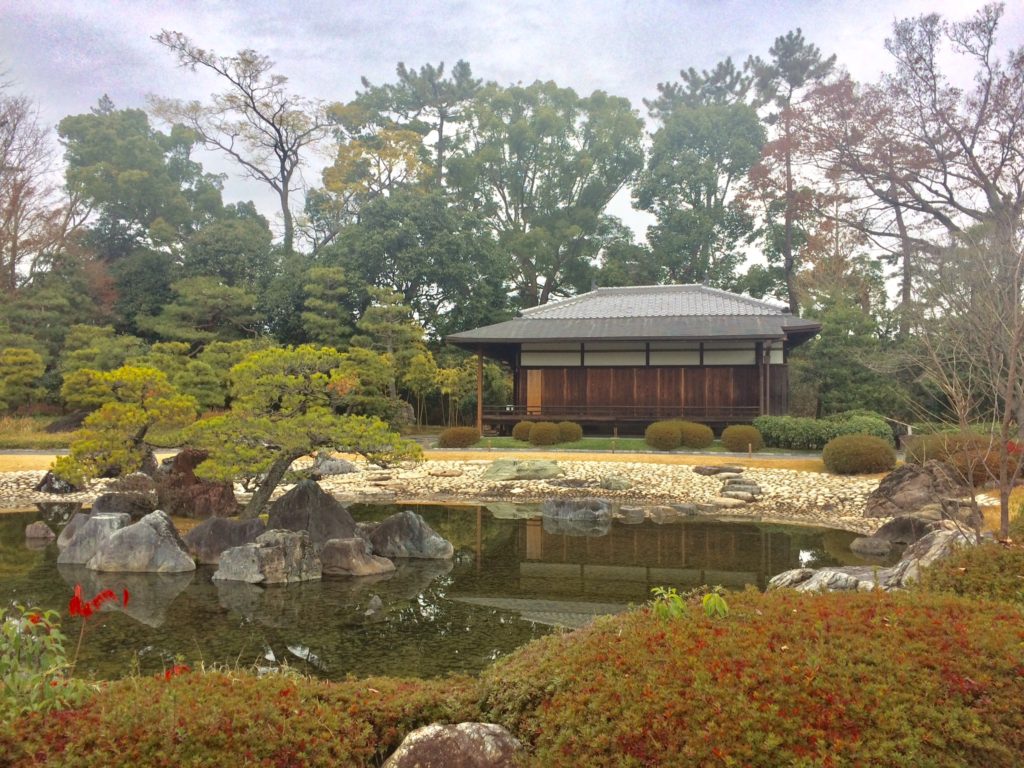
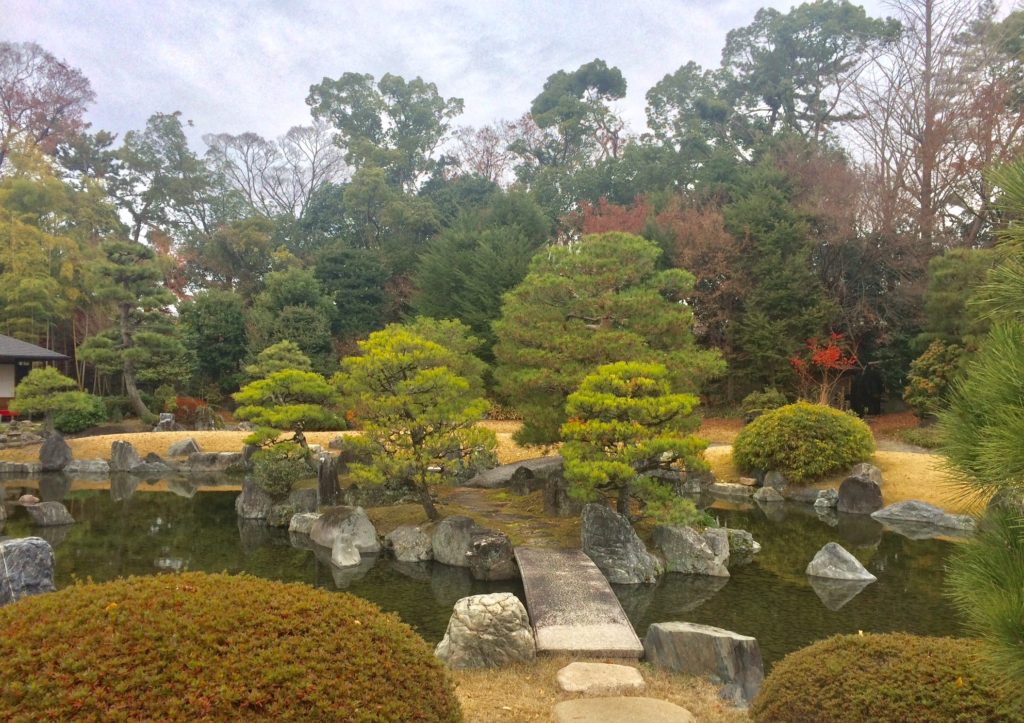
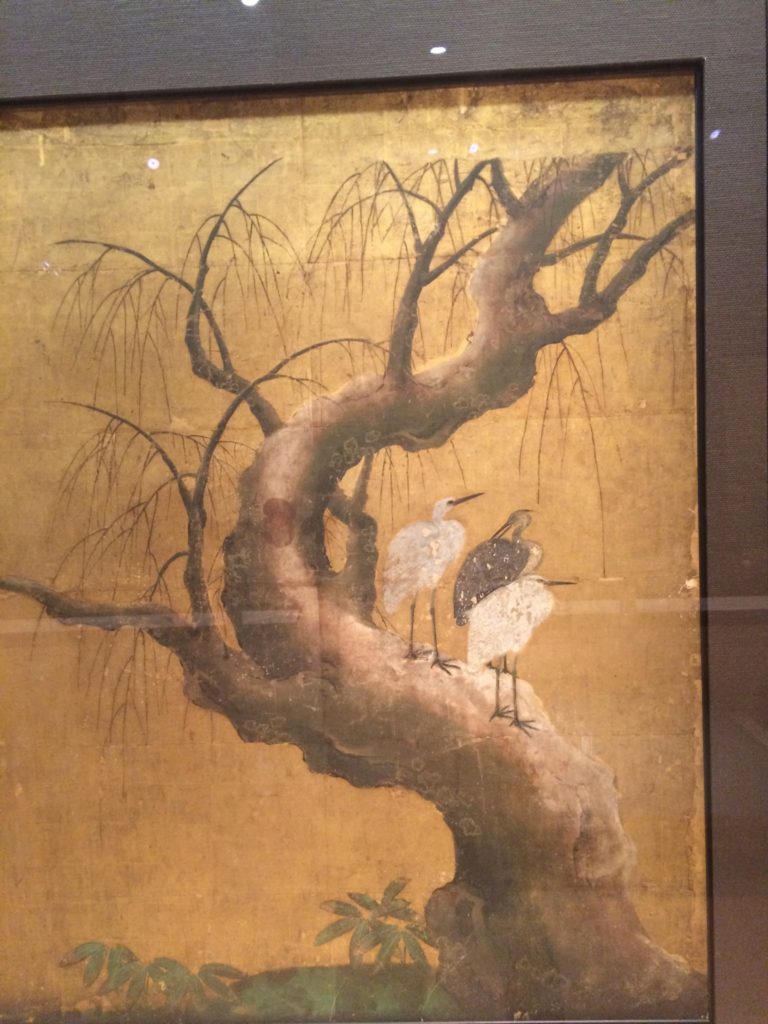
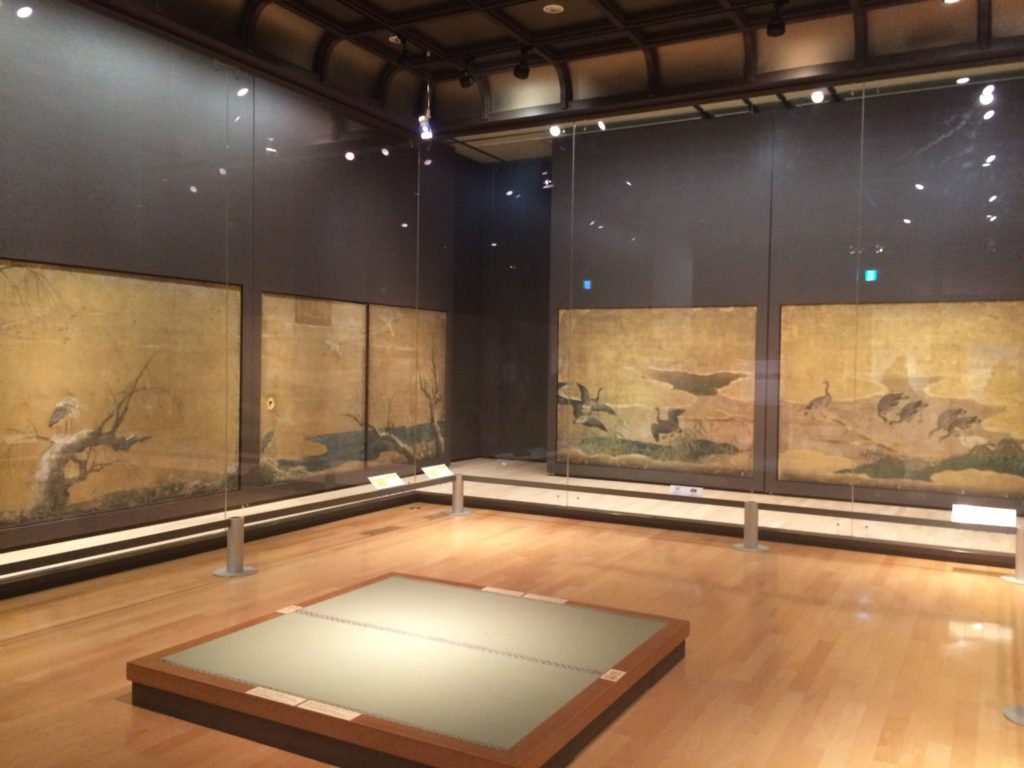
The Golden Pavilion
Kinkaku, the Golden Pavillion, is part of a Zen Buddhist temple. The garden and buildings were said to represent the Pure Land of Buddha in this world. The villa also functioned as an imperial guest house. Gold foil on lacquer covers the upper two levels of Kinkaku.
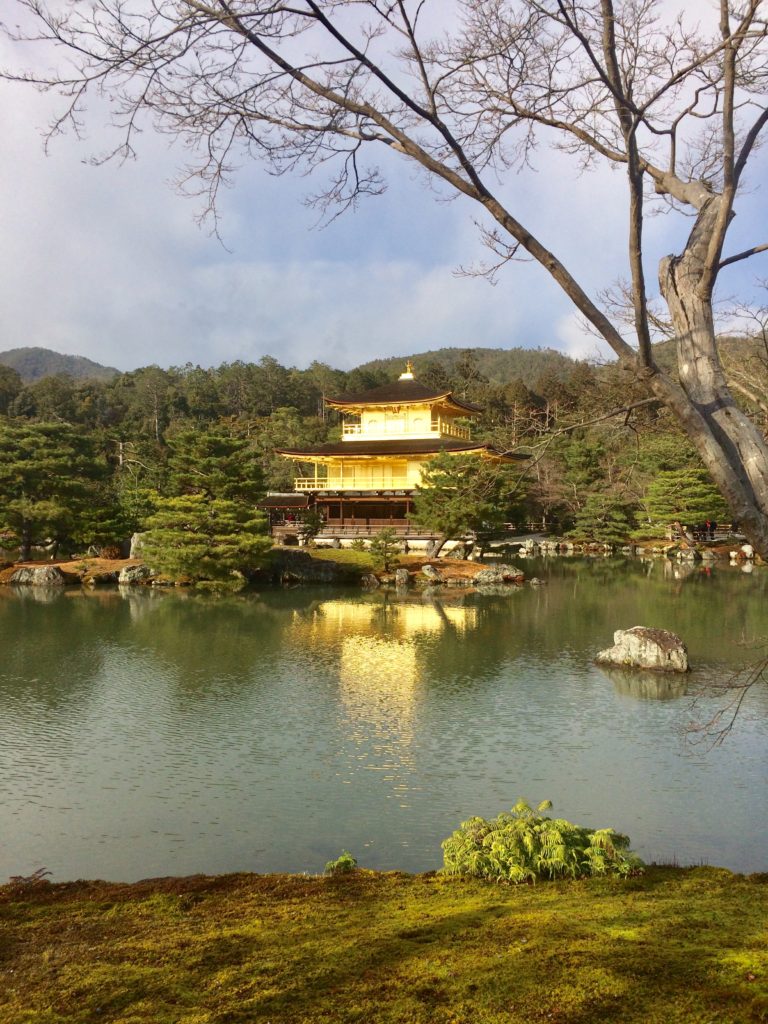
Mount Inari and its 1000 Torii vermilion gates
If having a vermillion gate is said to bring good luck, then it must be that 1000 gates would bring 1000 times more luck. Thus was the thinking at the site of a revered shrine ~ Fushimi Inari Shrine, perched high on top of Mount Inari.
Fushimi Inari is an important Shinto shrine and one of several thousands of shrines dedicated to Inari, the Shinto god of rice. Fushimi Inari Shrine has ancient origins, predating the capital’s move to Kyoto in 794 ~ more than 1200 years ago!
There are two ways to go to the top of Mount Inari ~ one is through a crowded path, up through what seems like an unending series of closely built vermillion colored torii (gates). The other option is to hike through the bamboo and pine forests on the side of the mountain, leading to the top after climbing many steps with small shrines along the way. We opted of course for the blissfully un-crowded approach and ended our two hour hike by walking downhill through the 1000 gates.
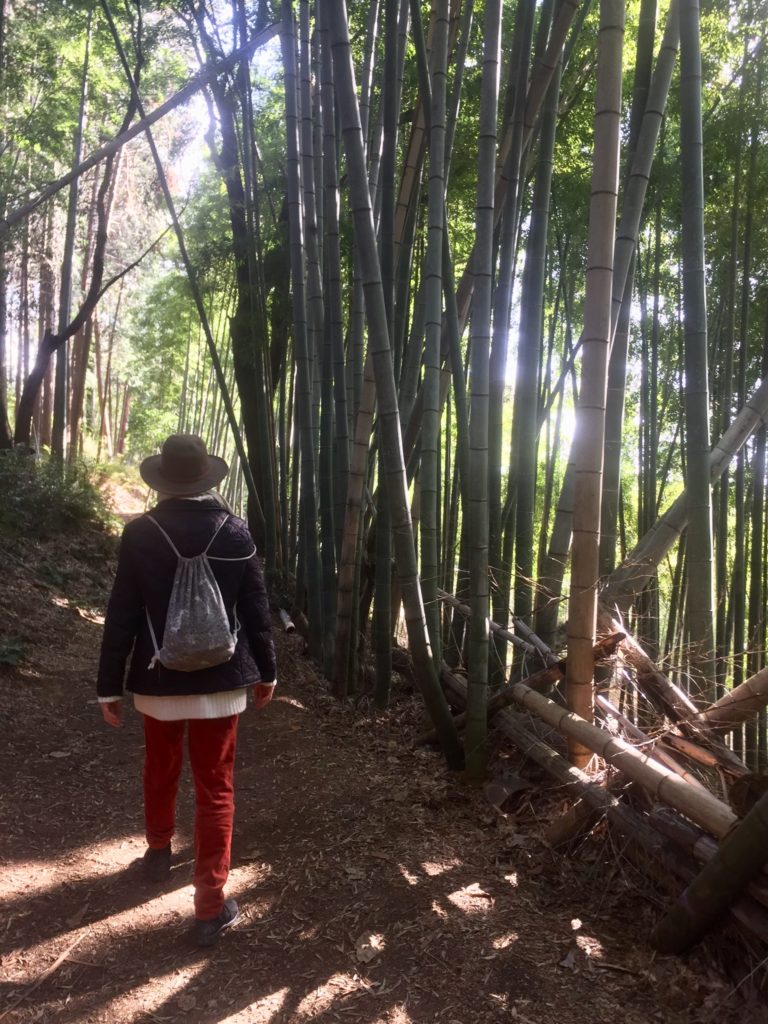
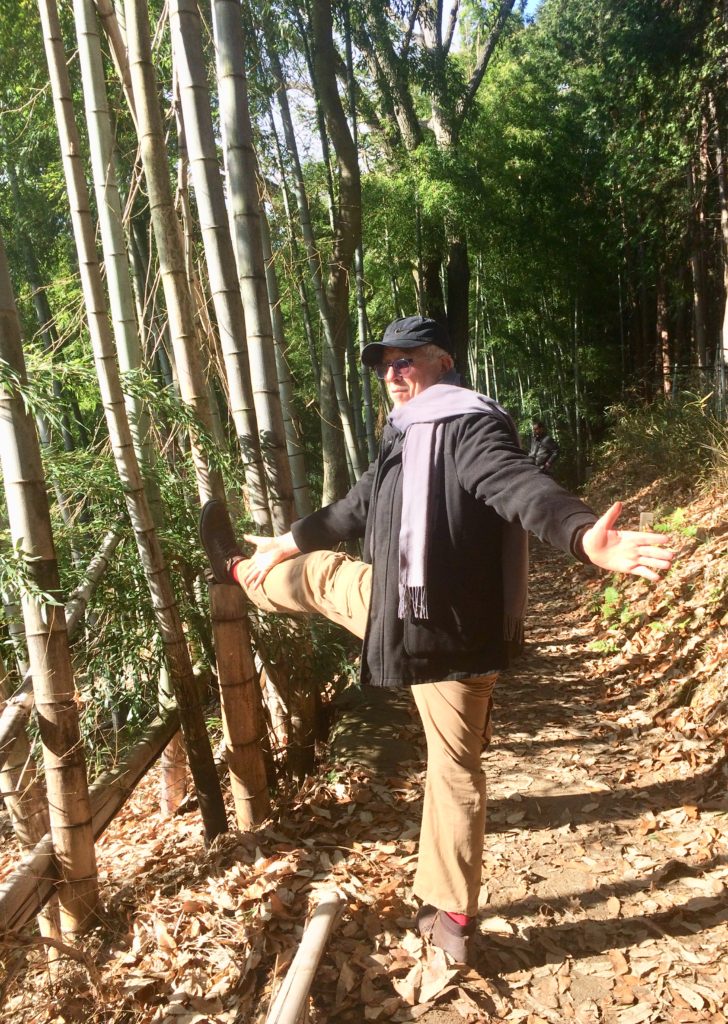
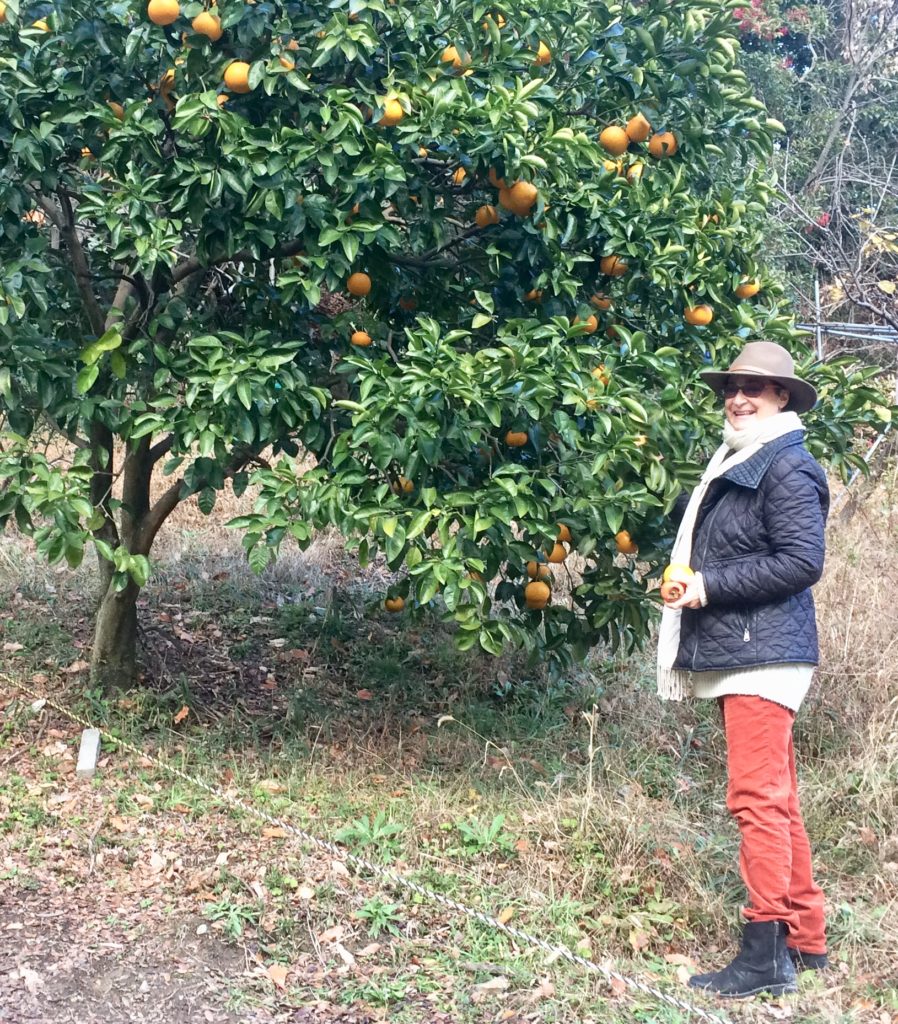

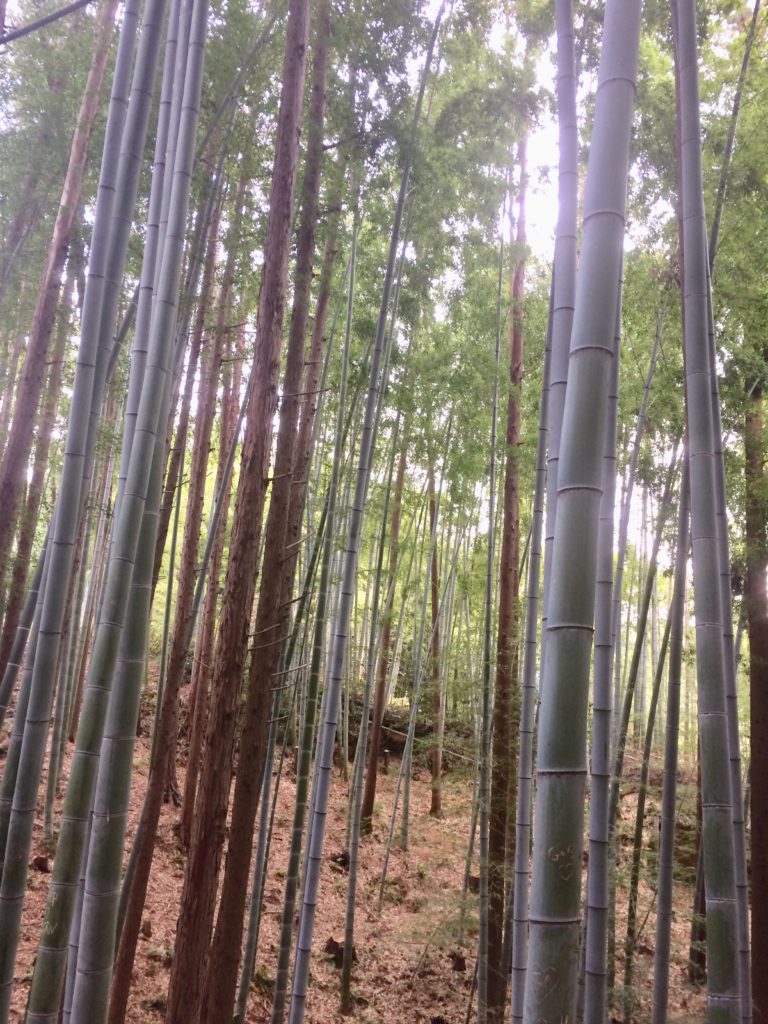
Foxes are thought to be Inari‘s messengers, (all Shinto gods are paired with an earthly creature, which allows them to take shape and interface through these messengers with the physical world). As a result, there are countless fox stone statues throughout the shrine grounds.
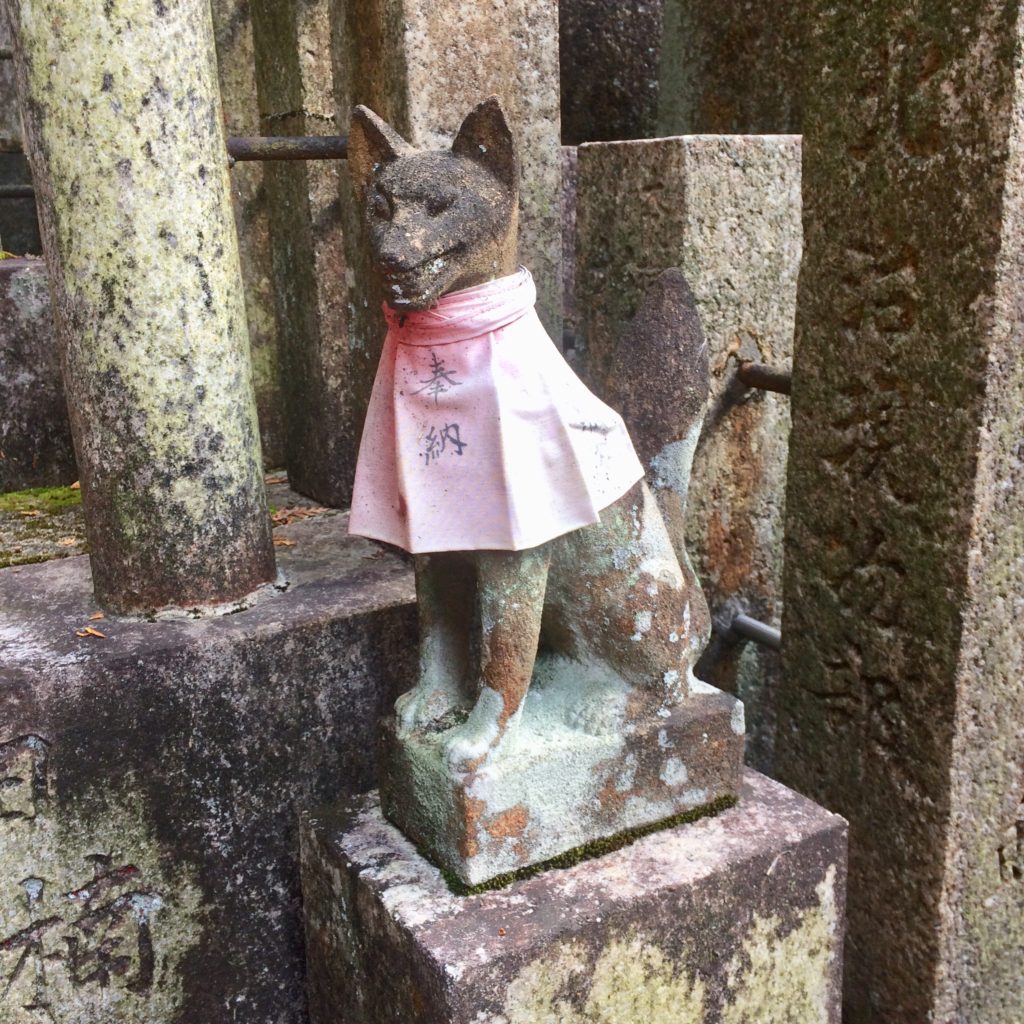
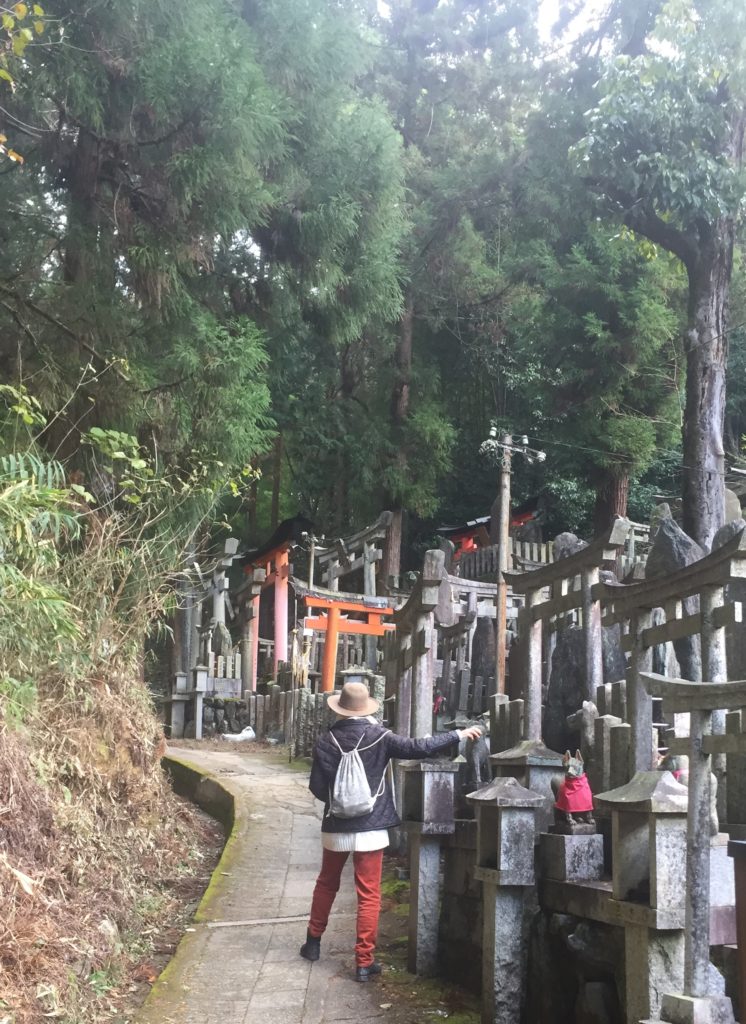
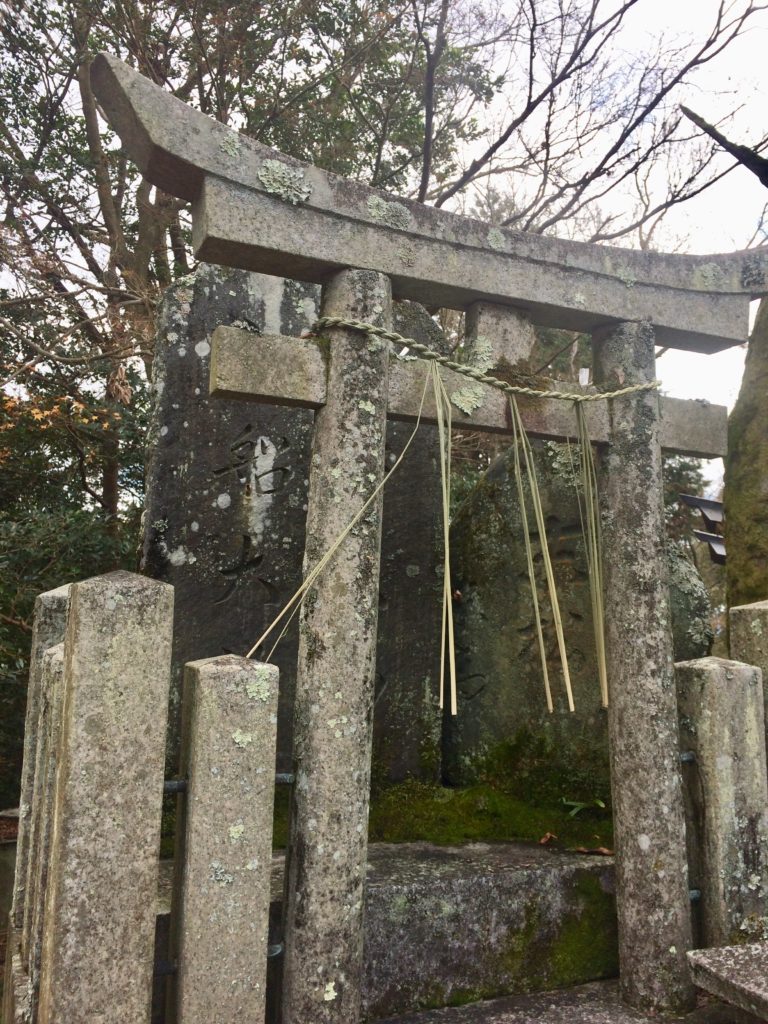
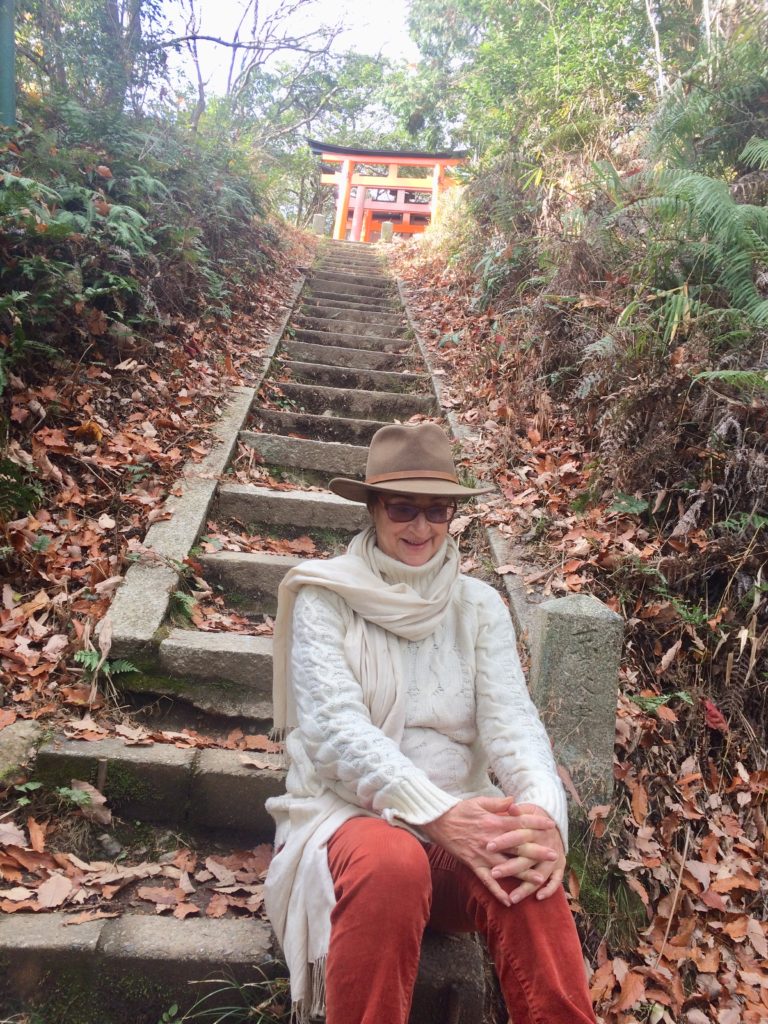
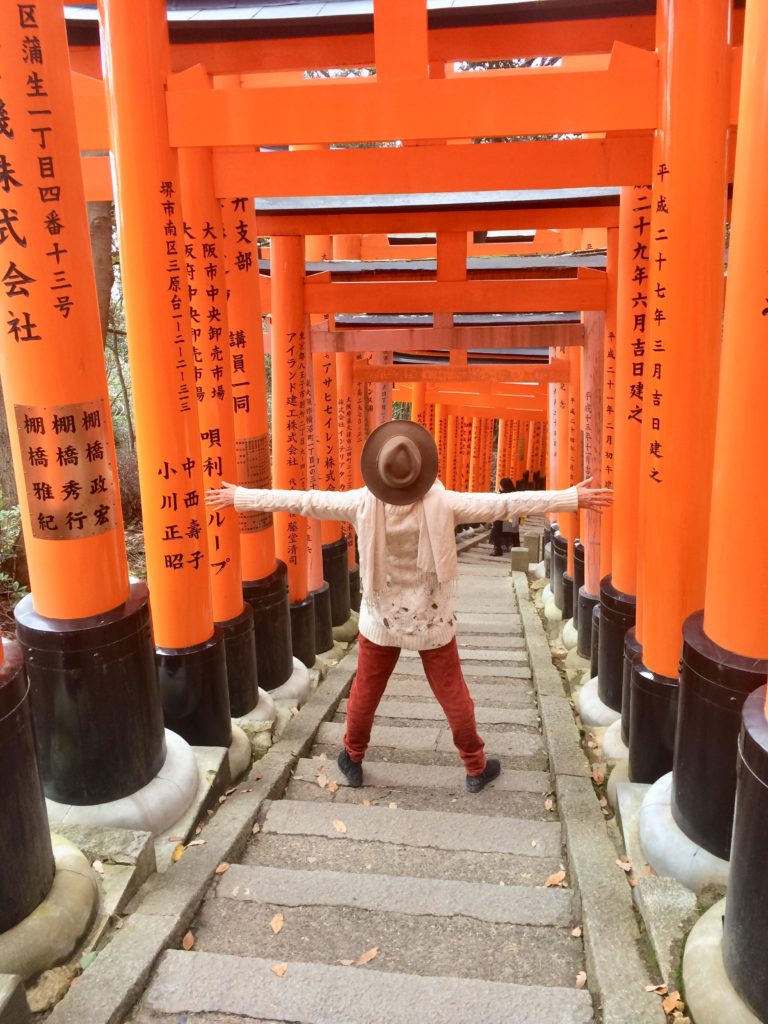

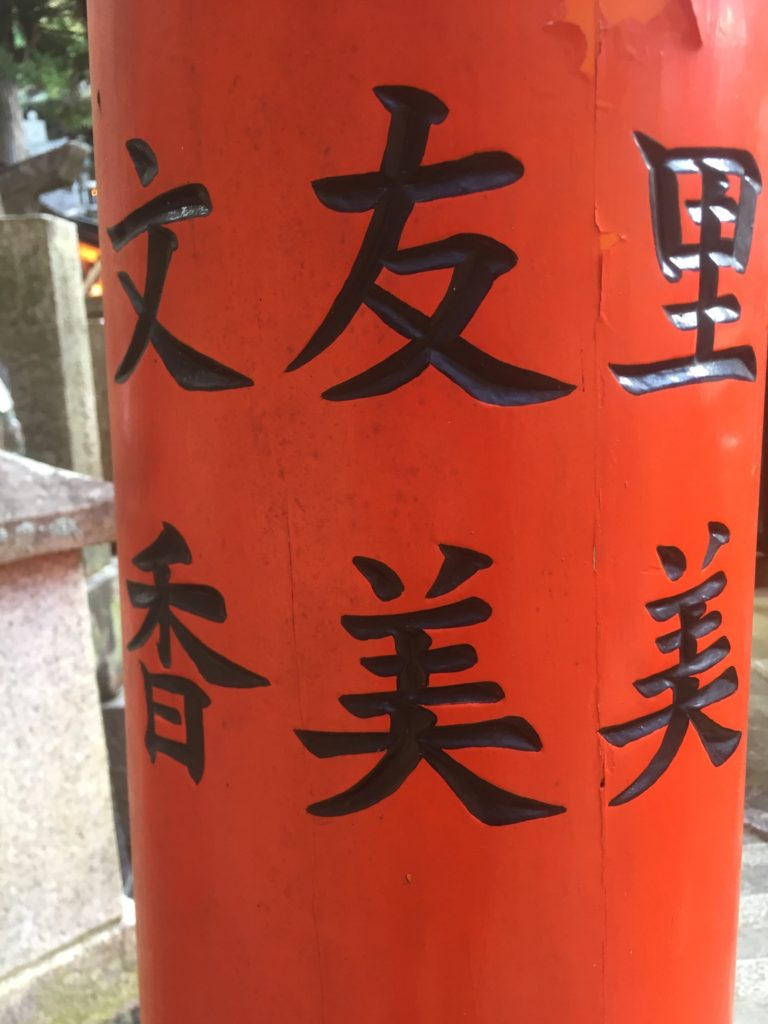

A temple complex at sun down
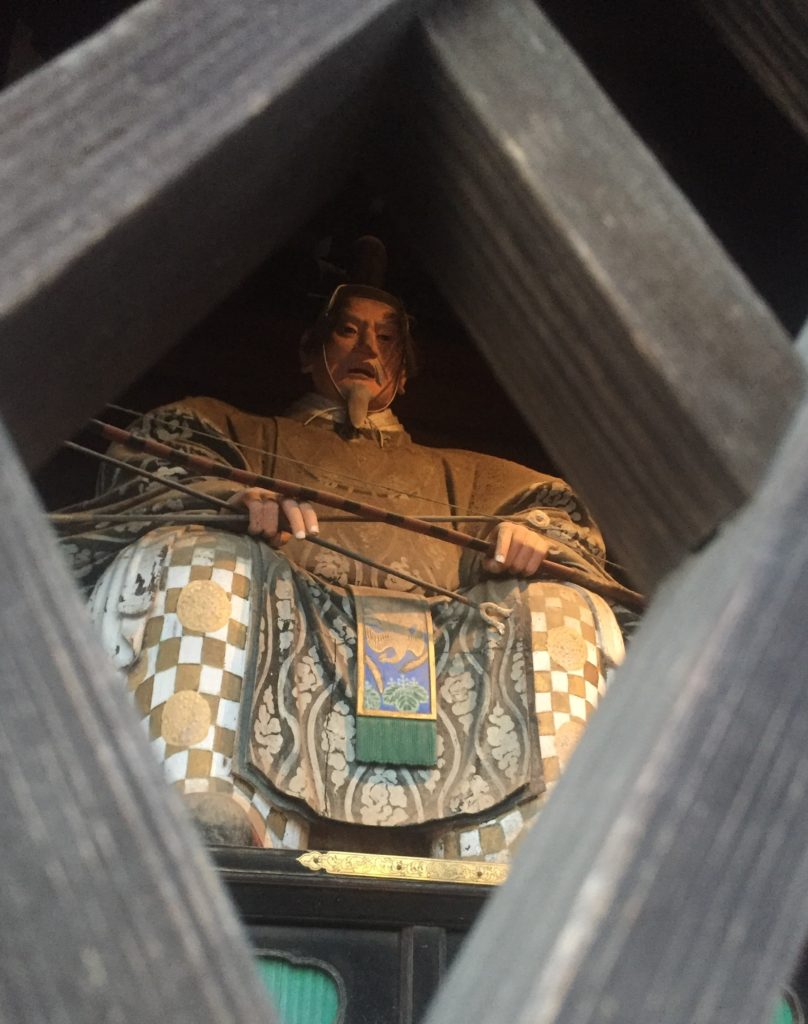
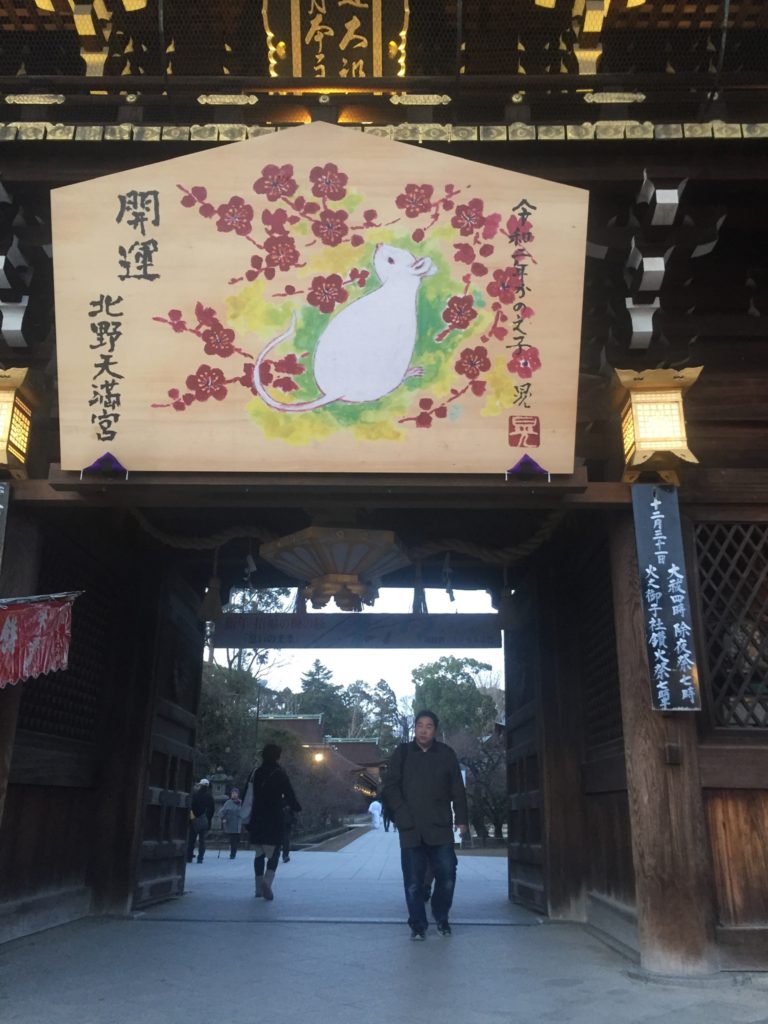
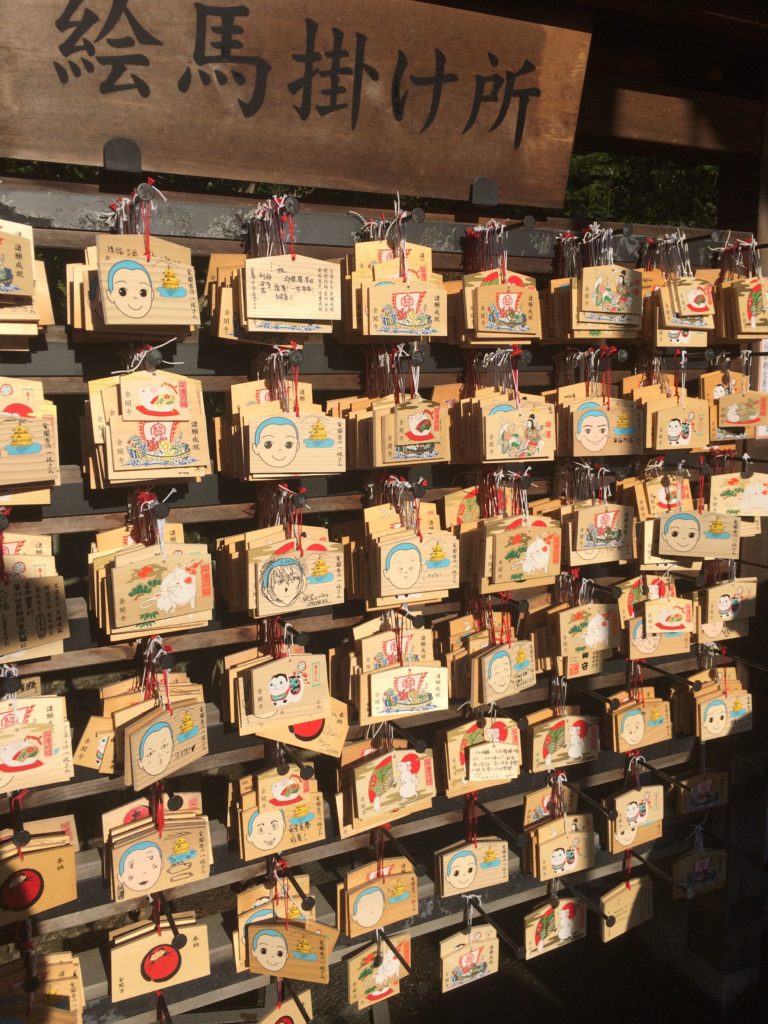
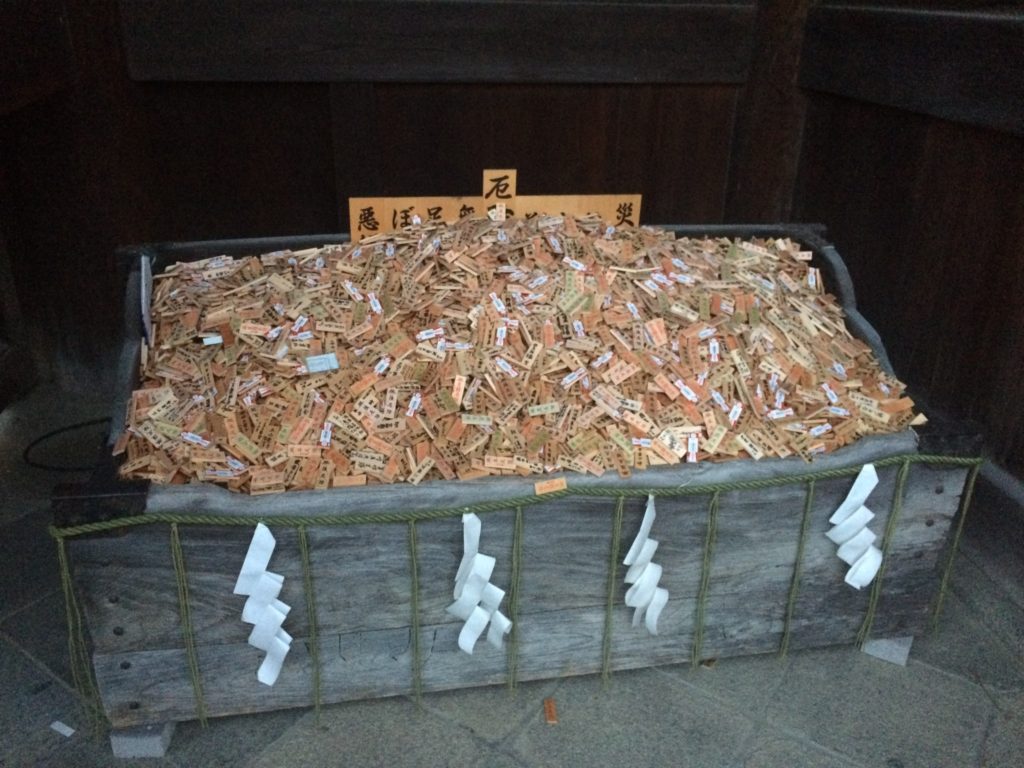
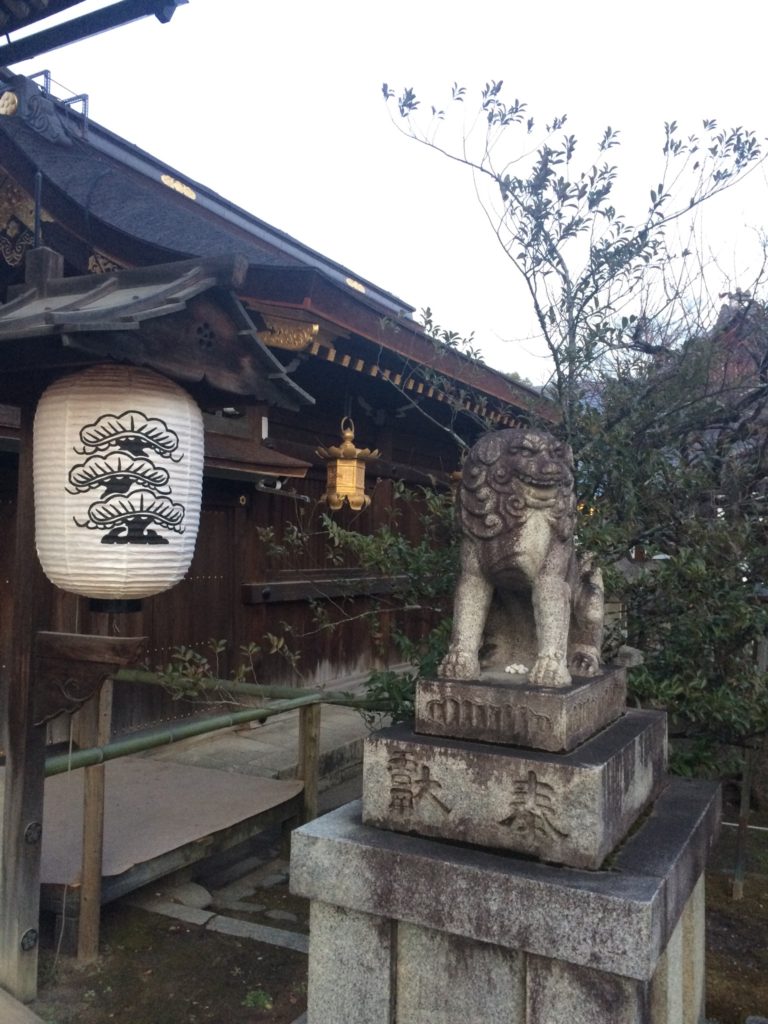
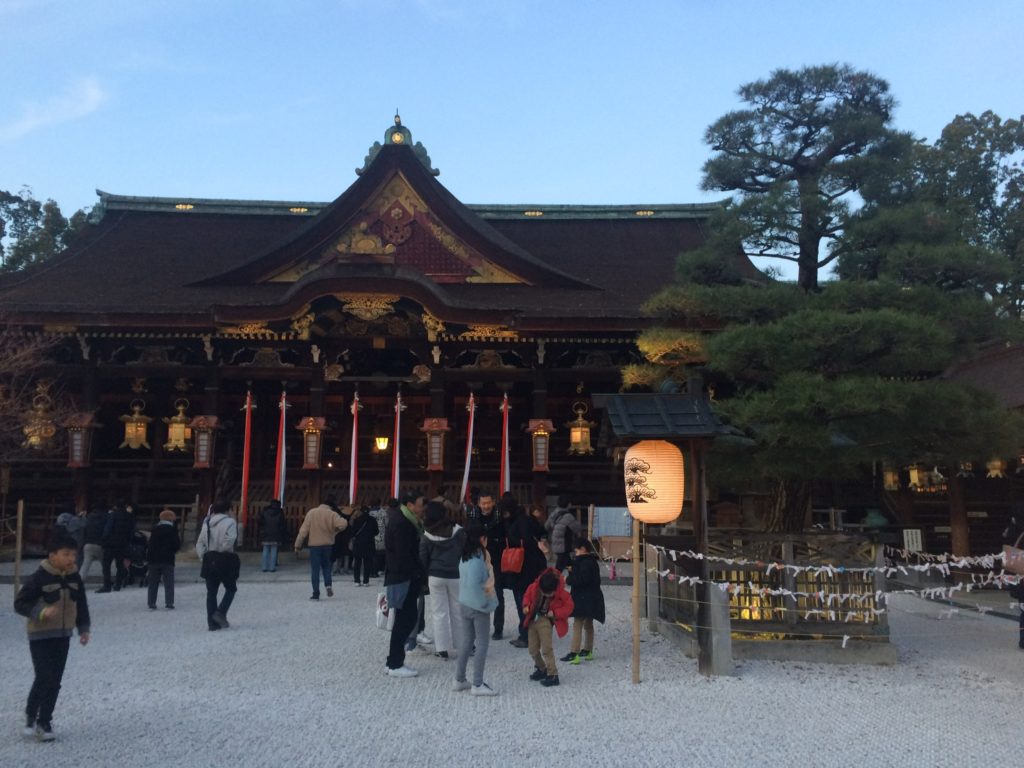
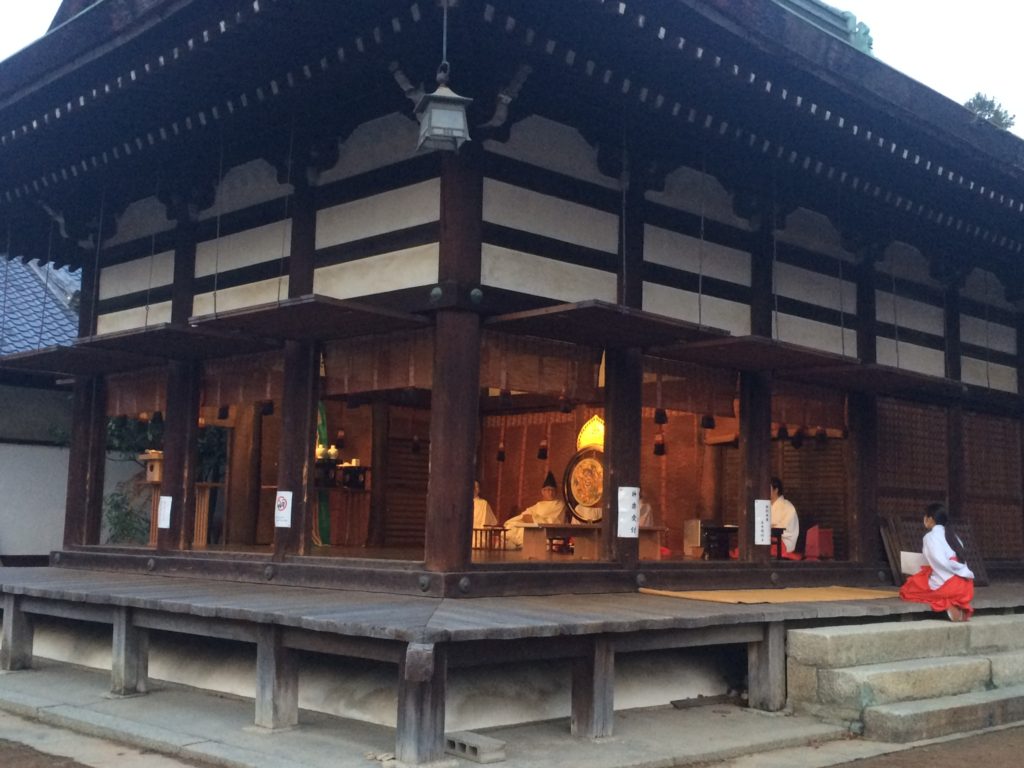
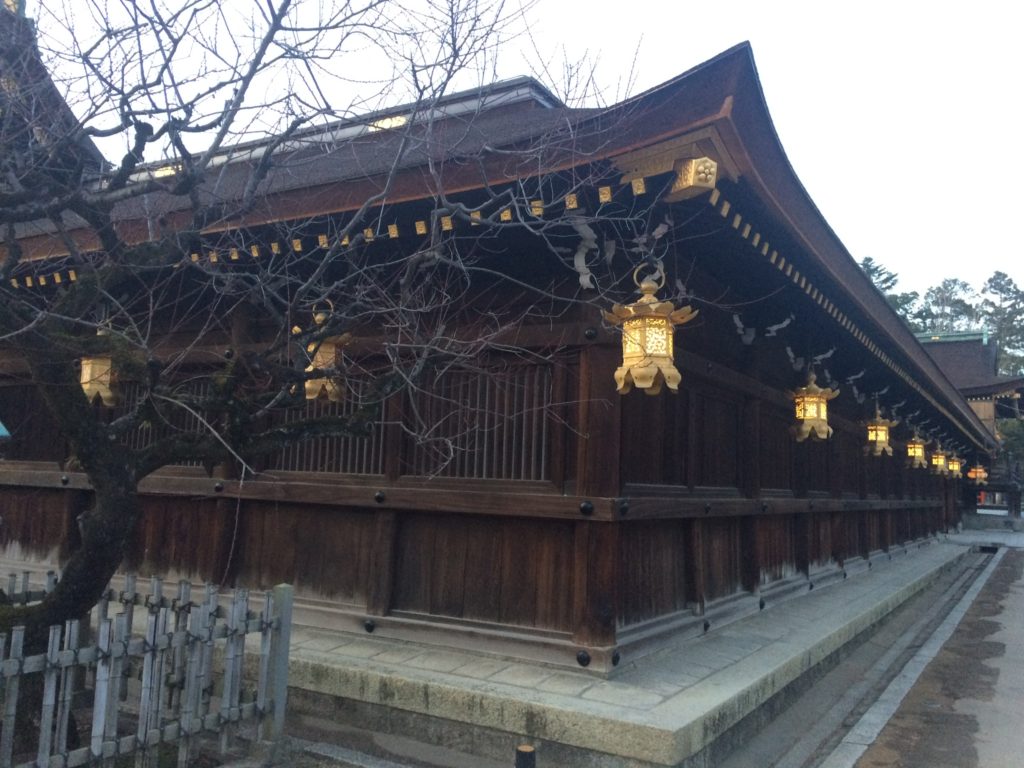
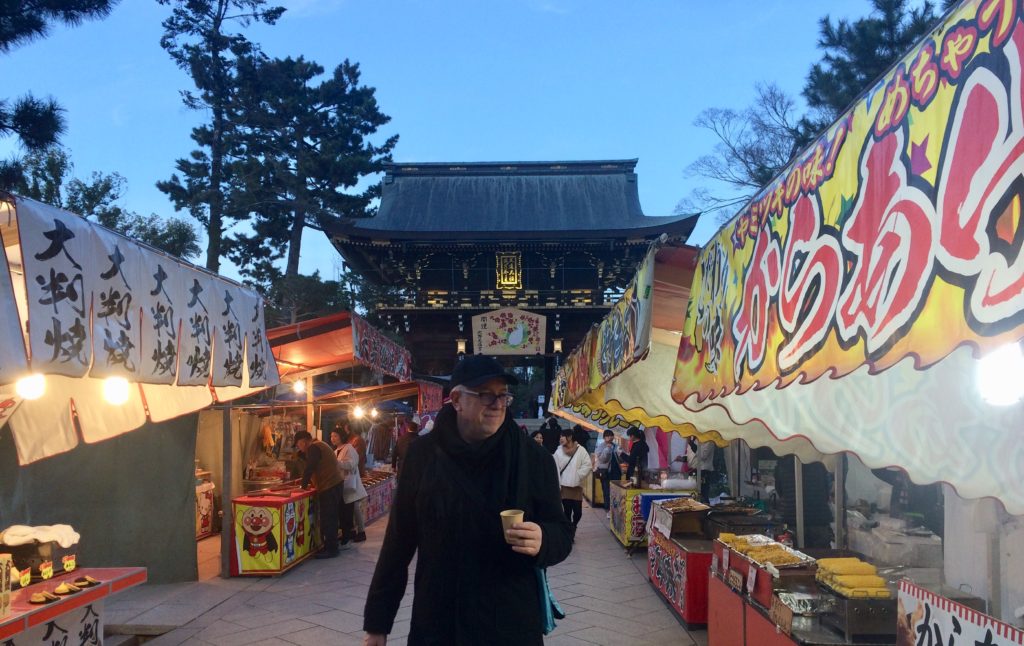
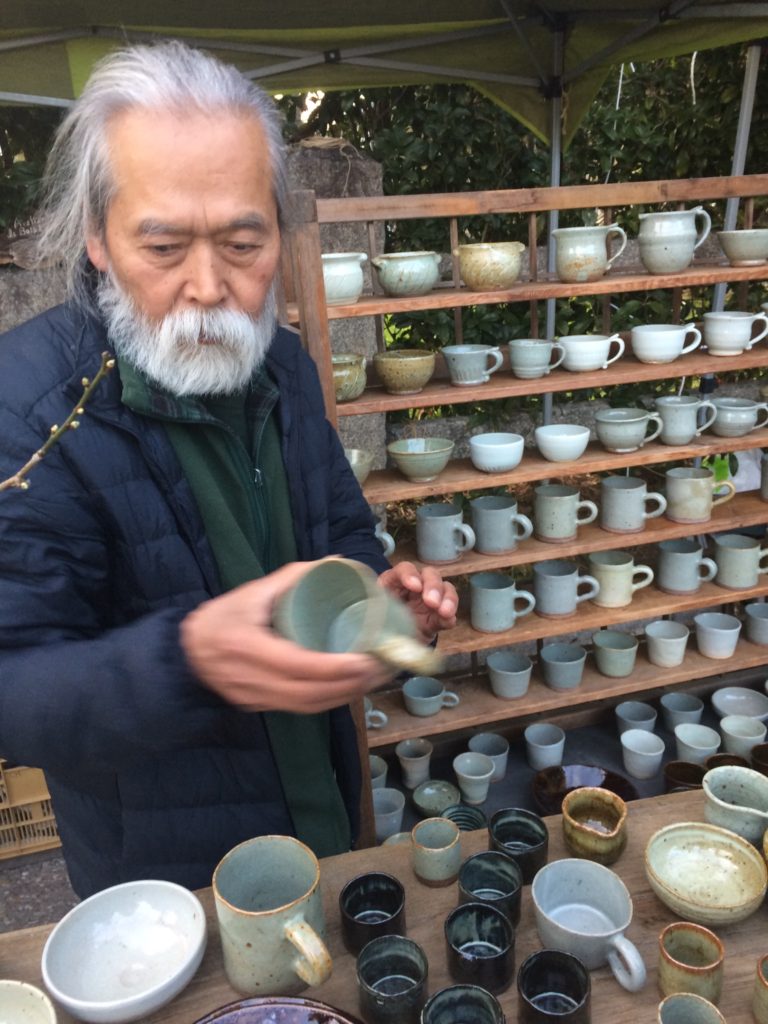
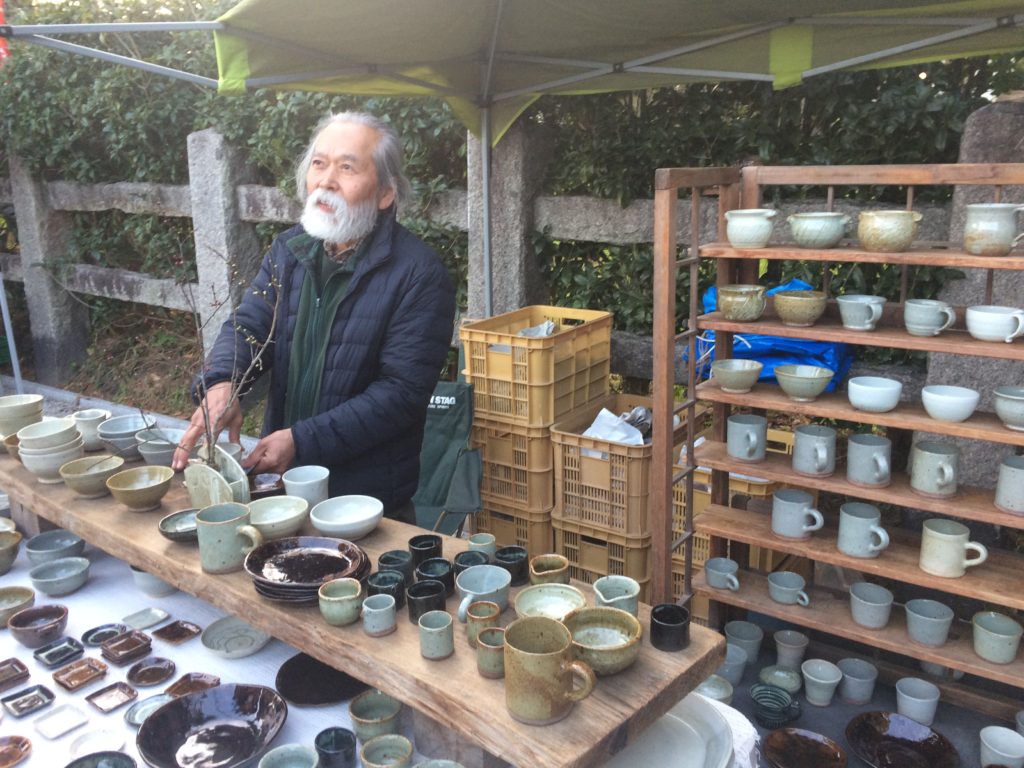
Kyoto culinary specialty
Our days in Kyoto always include a lot of walking, usually till our feet ache. As another day draws to a close, and we cannot take another step, we assess what specialty meal awaits us. Kyoto is famed for its tofu, as is the broader region of Kansai. Normally not big tofu eaters, for health reasons as it is made from soy, but of course we are not about to skip a specialty of the region. In Nara, we were amazed at the range of tastes of the tofu components of our traditional breakfasts. We are eager to sample Kyoto‘s tofu specialty.
We spot one cab outside the garden we have just visited and this is where Ben’s Japanese language becomes so helpful. After some back and forth banter in Japanese, the cab driver asks Ben if he grew up in Japan, as he is impressed by Ben’s accent as a gaijin (foreigner). Ben asks the driver if he can recommend a tofu specialty restaurant (one that is for locals, not for tourists). The driver makes a few calls to friends, having established that we have the necessary credentials to not be disruptive as foreigners, and we are soon on our way.
In Japan, Western foreigners are generally perceived as being loud, prone to cultural missteps and not viewed as ideal customers for authentic small and more upscale dining venues that strive for harmony and a tranquil atmosphere for their Japanese dining guests. On two occasions during our week in Kyoto, we stepped off the street into tiny restaurants which had no English signs outside, and faced uncomfortable looking hosts who quickly informed us, even though Ben spoke Japanese, that they were full, even though, they clearly were not full. Ben was not at all surprised at our being turned away, because in his experience (living in Japan for 5 years), this happens frequently to foreigners. He has often mentioned that if any Caucasian wants to get a taste of the experience of racism in the U.S. (against blacks, Latinos, Muslims), just spend some time in Japan and see what it feels like to be shadowed in stores, and turned away in restaurants.
The taxi driver stops outside a small non-descript restaurant. He parks his cab and donned in a suit and tie and white gloves (which are the norm for taxi and uber drivers in Japan), he personally introduces us to the host at the entrance of the restaurant ensuring us we are about to have a special dining experience and ensuring them, that we are appropriate customers, even though foreigners. No one in the restaurant from the host, to the chef, to the server, speaks English.
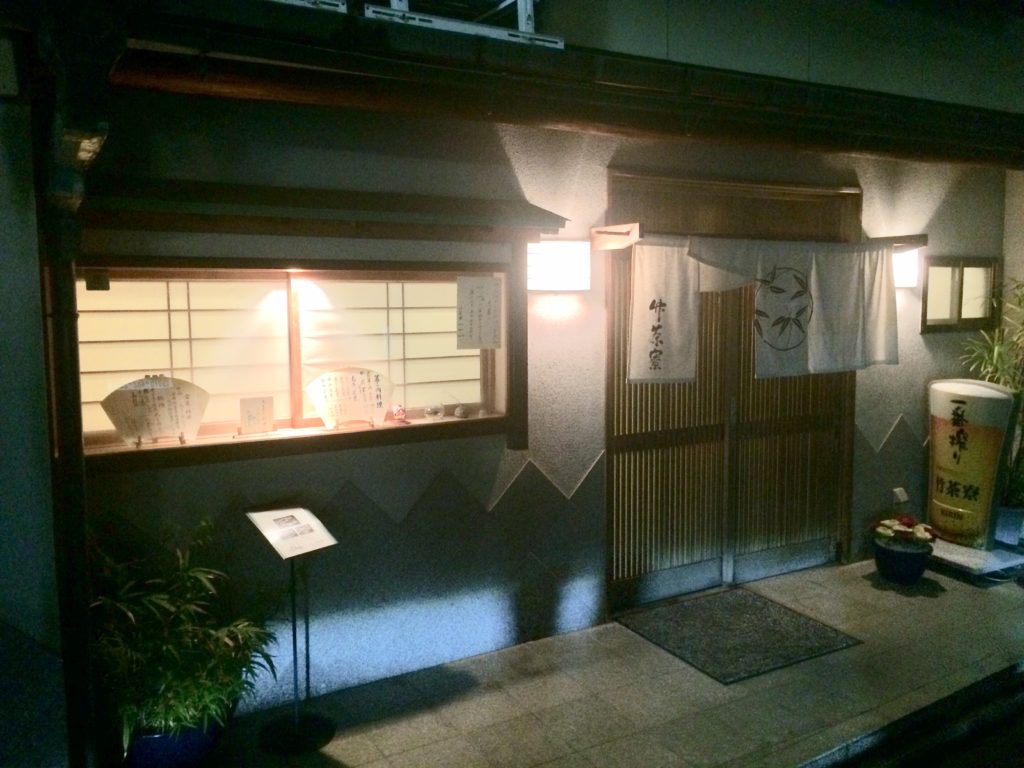
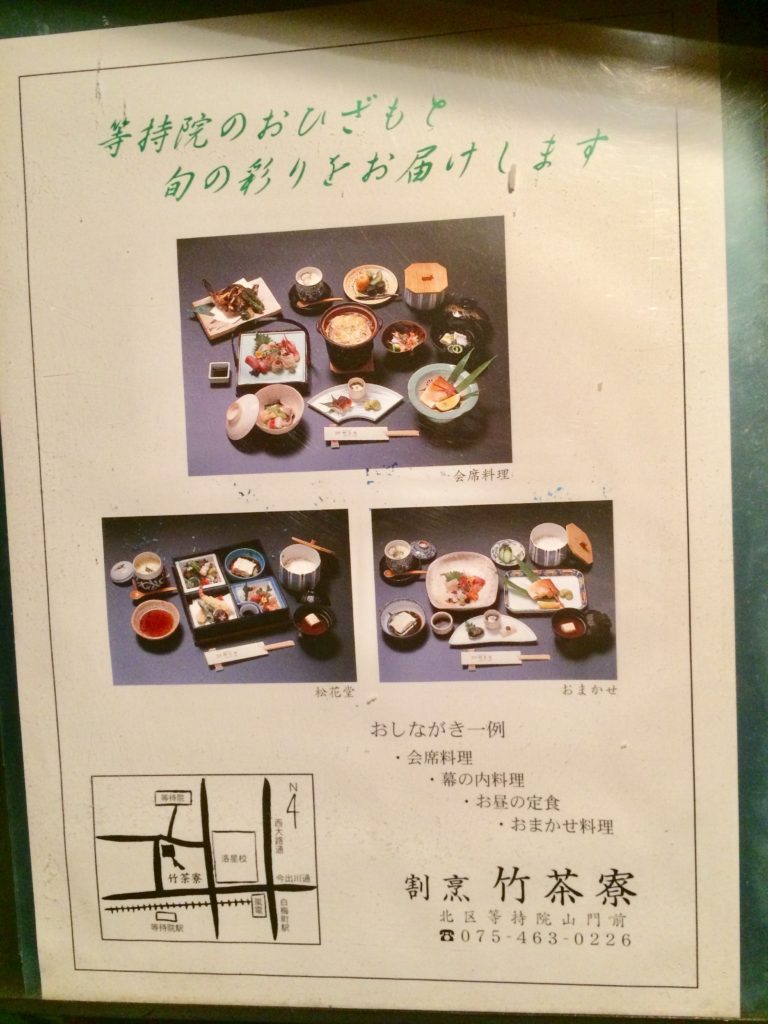
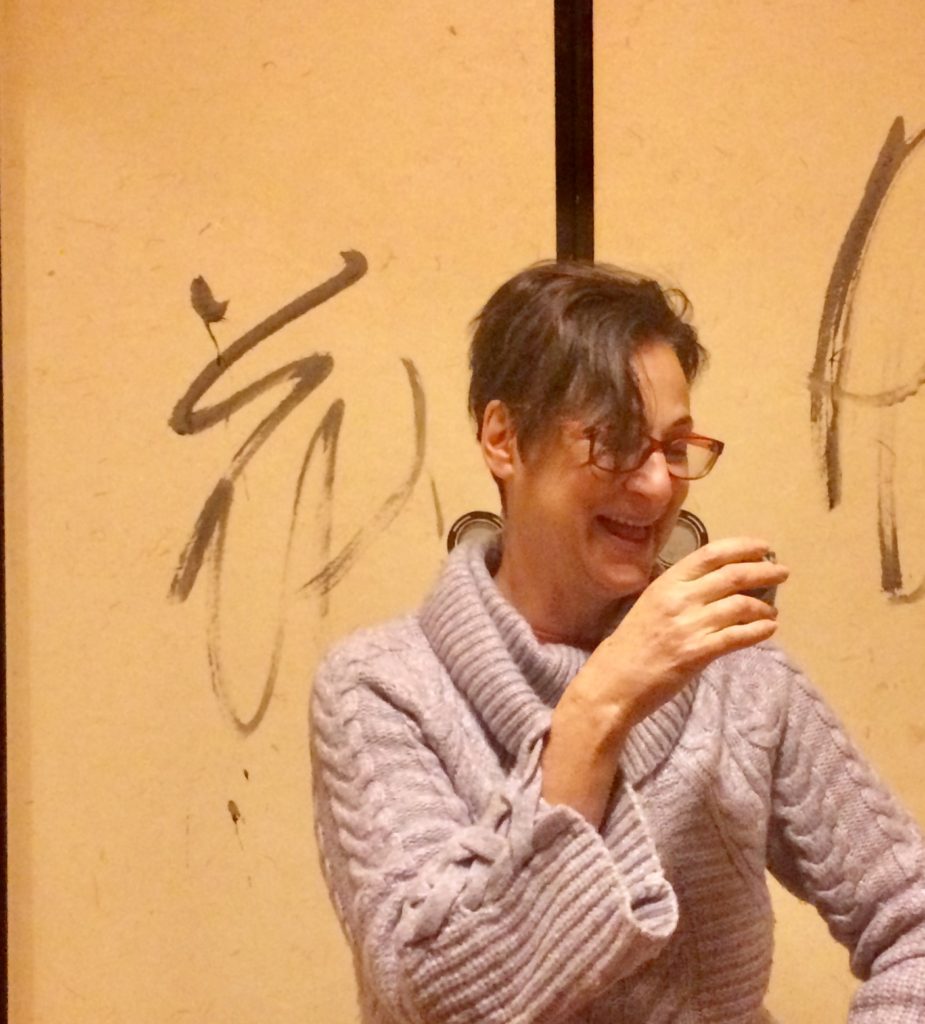
Two by two, dishes of tofu are brought out to our private tatami room. They may not look like much, but the flavors, textures, freshness and variety are both surprising and memorable. One of our favorites (top left) a very soft tofu in a delicate sauce, which was reminiscent of French fromage blanc, somewhere in consistency between sour cream and yogurt. The chawan, on the right, is a tofu custard with mushrooms and hidden root vegetables at the bottom of the bowl, awaiting to be discovered.
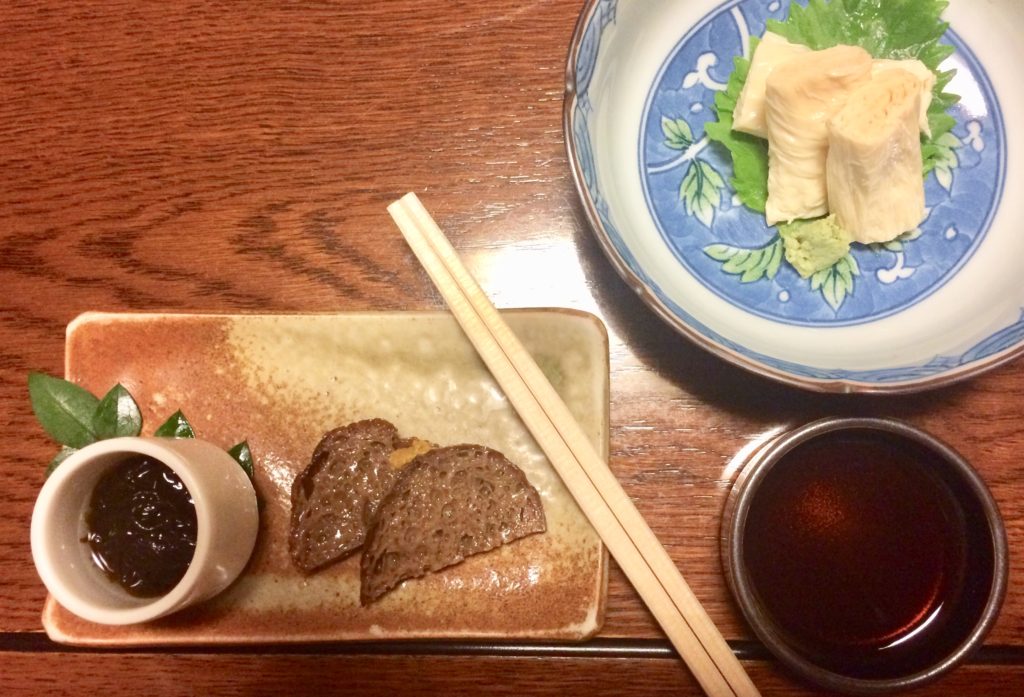
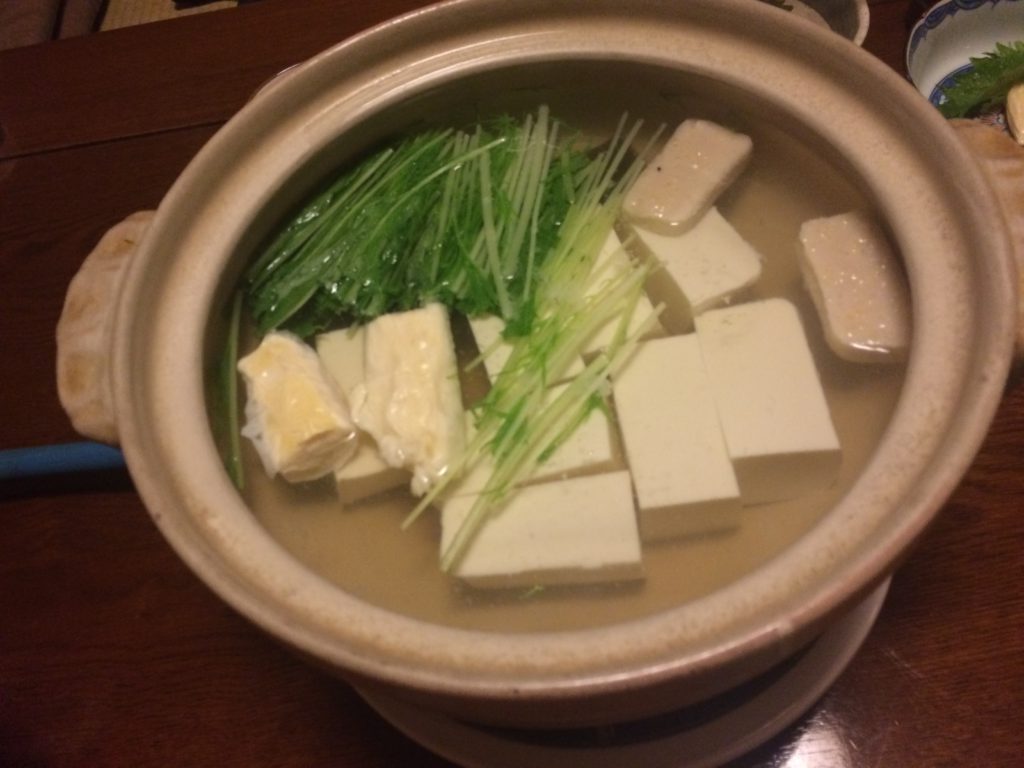
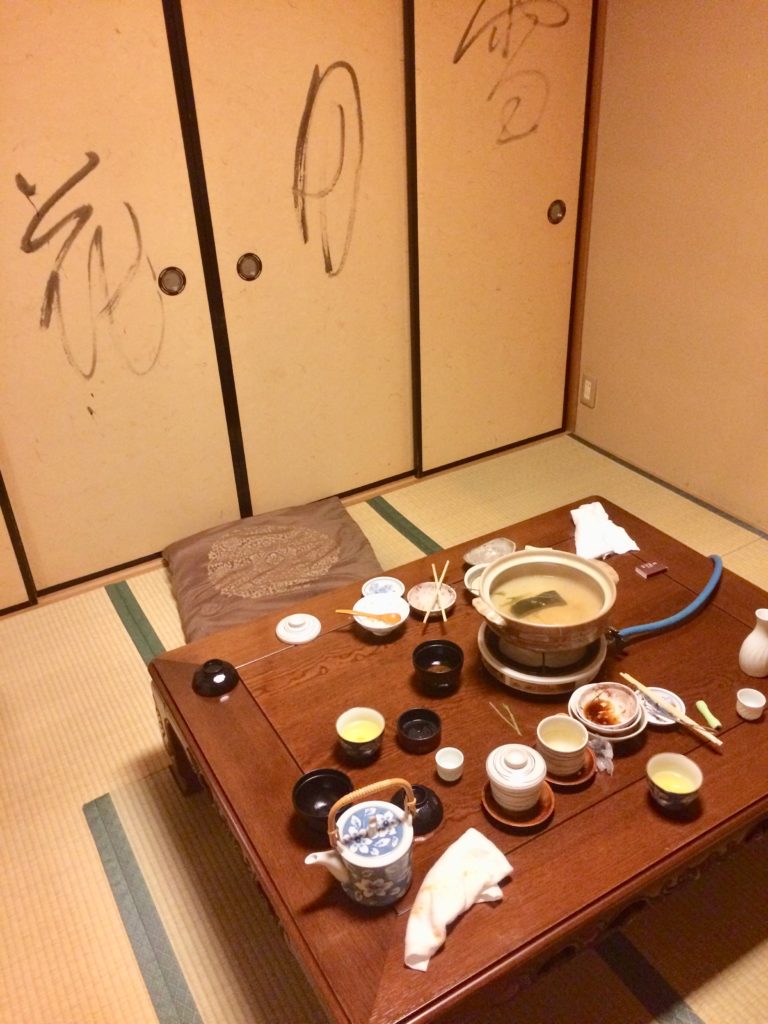
Lest we leave the impression that great food in Kyoto must be had in upscale settings, most of our meals were in humble and cheap, yet delicious ramen or soba shops and yakitori bars.
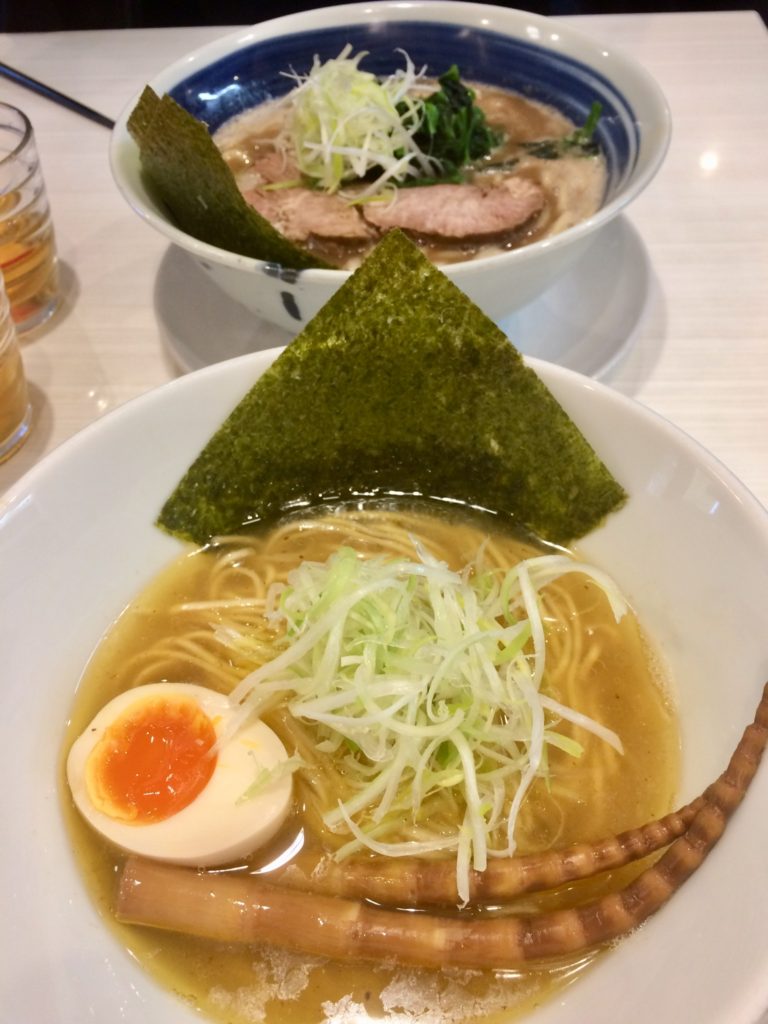
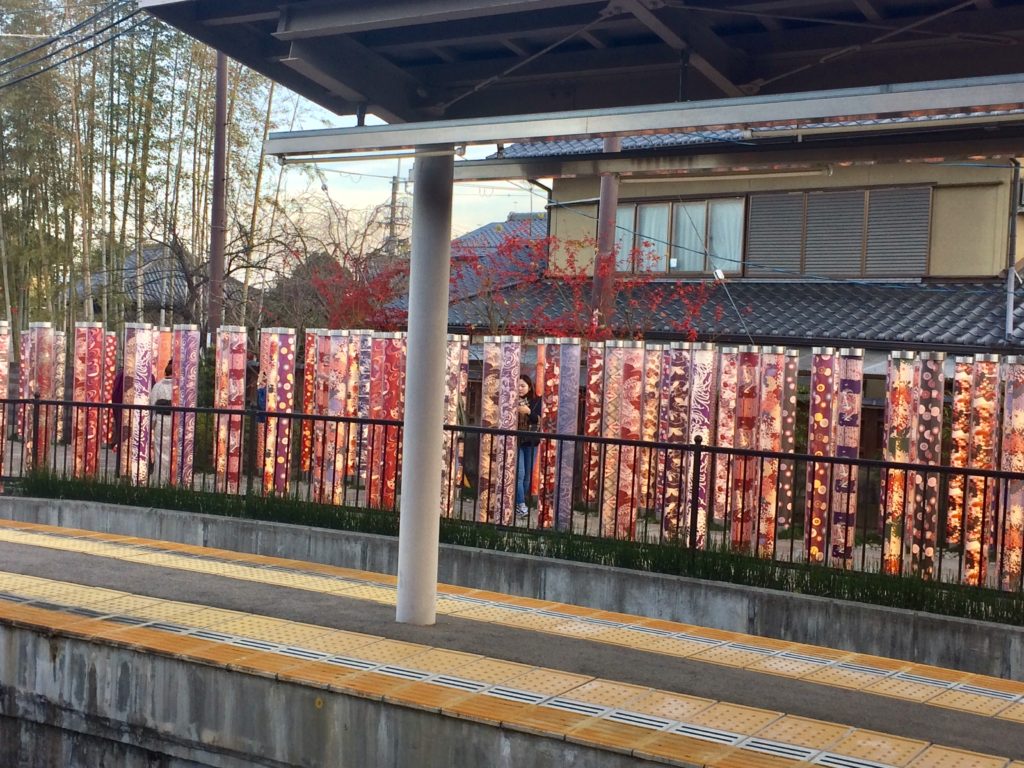
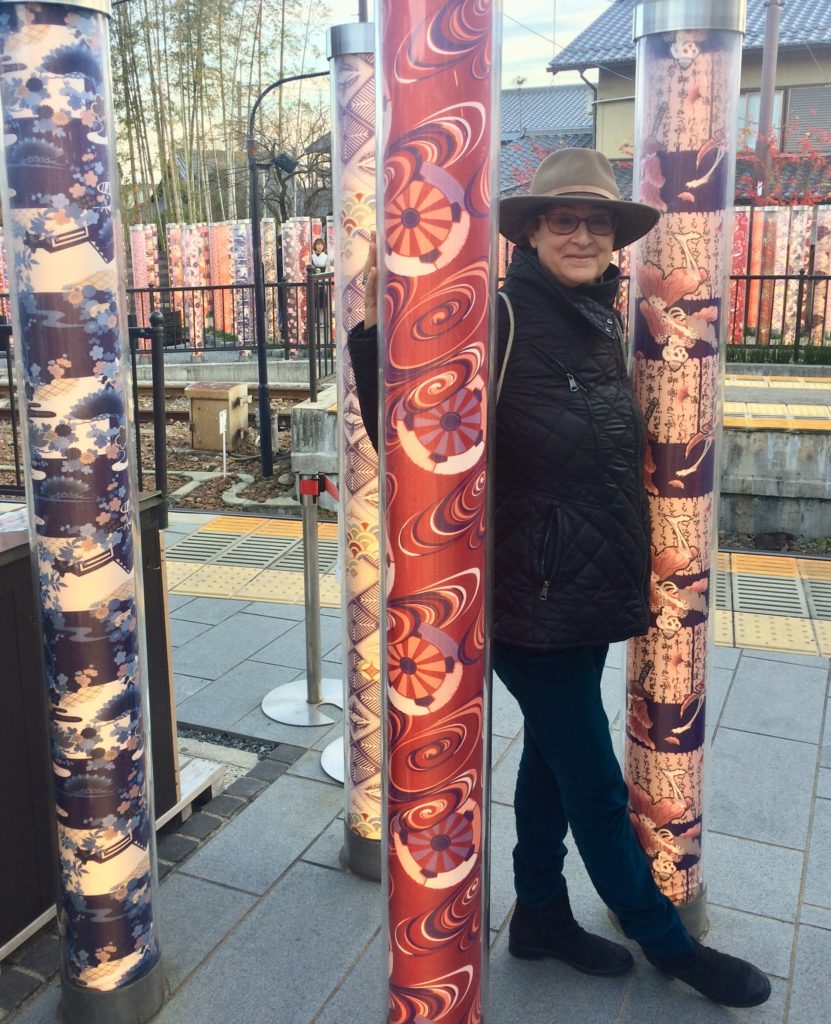
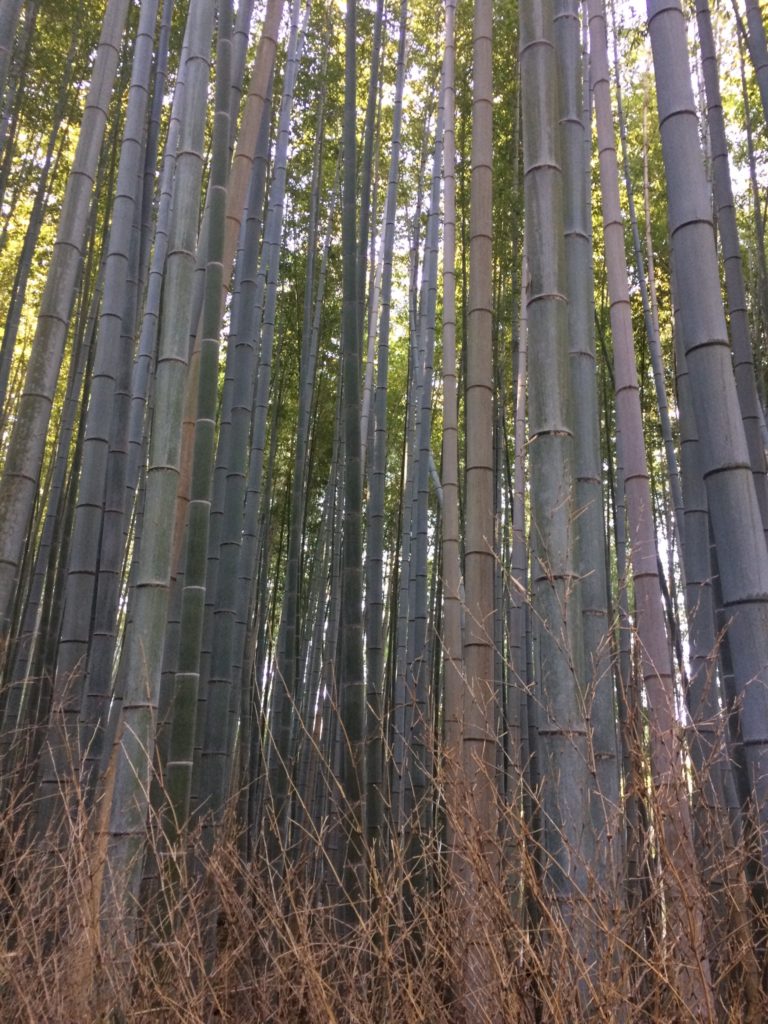

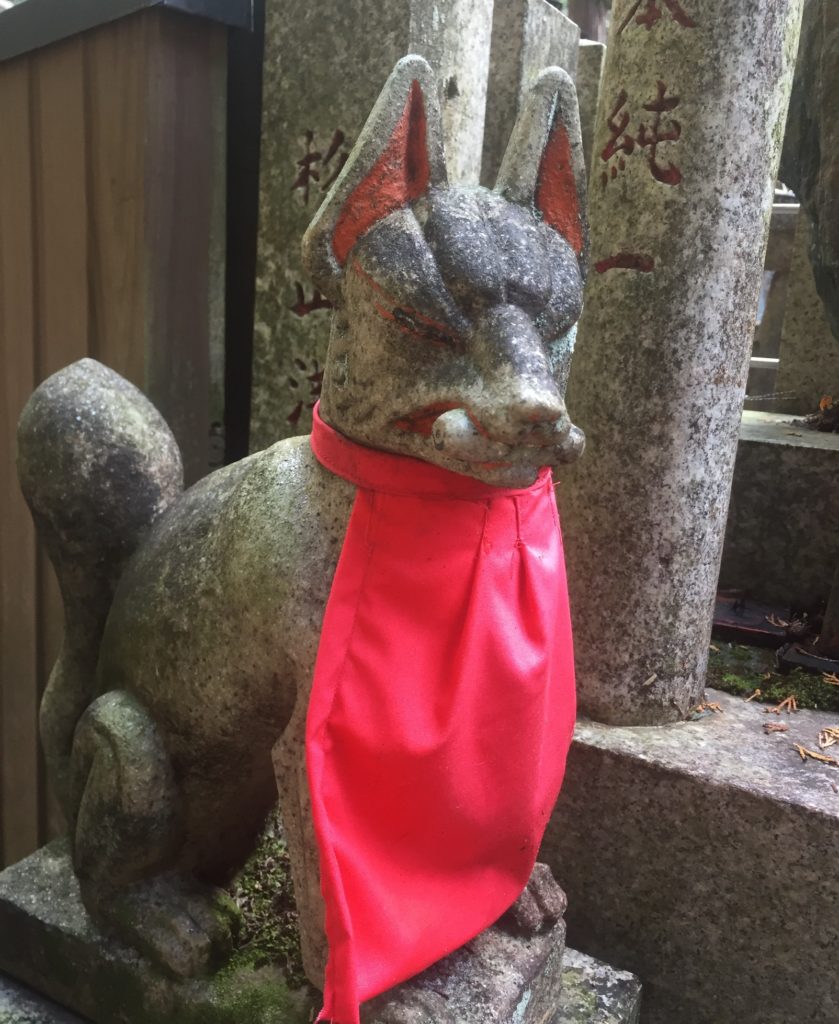
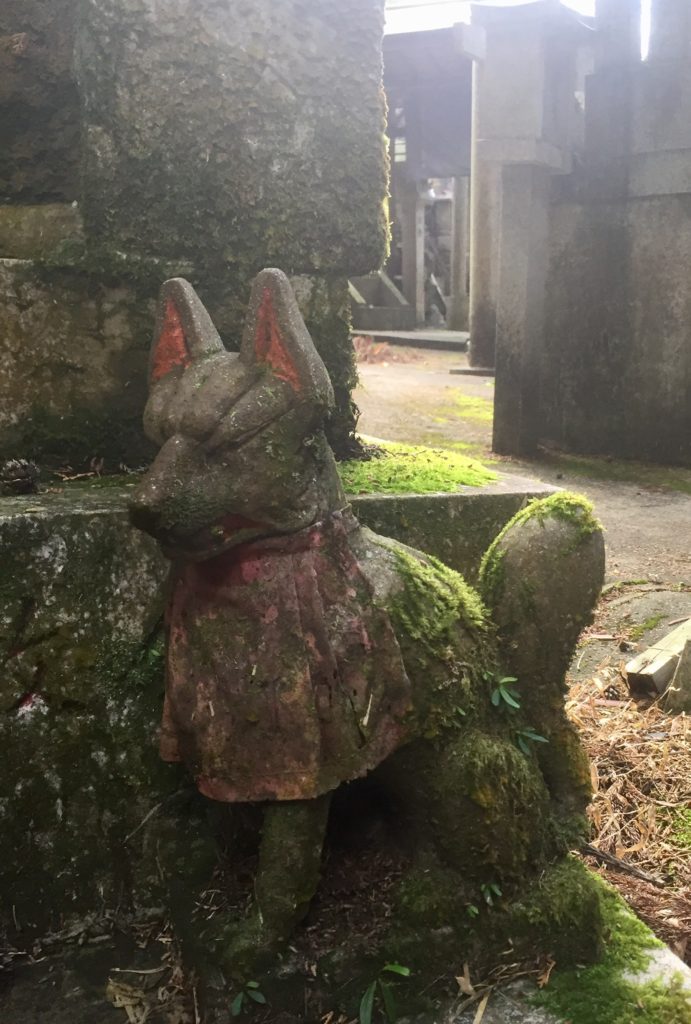
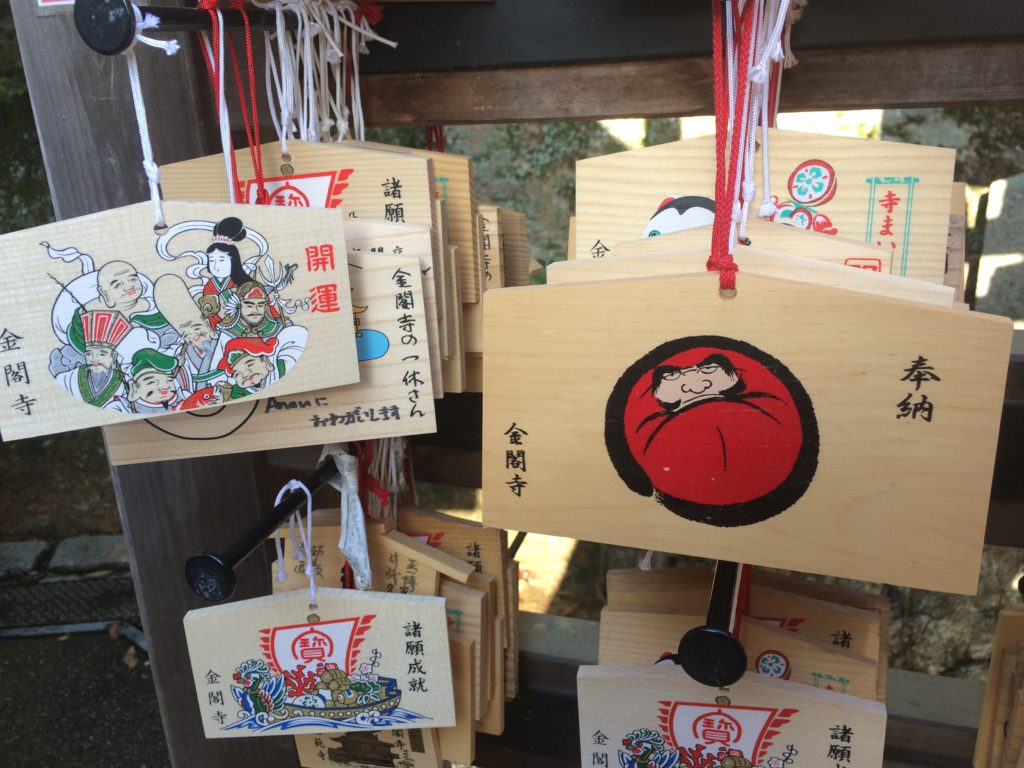
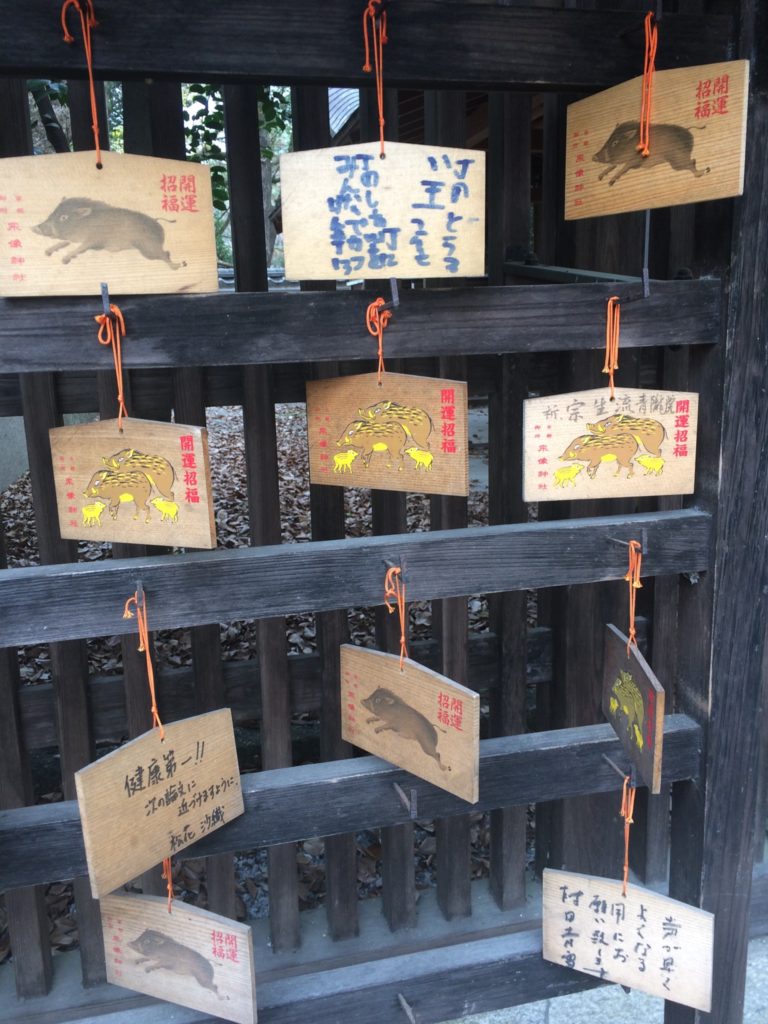
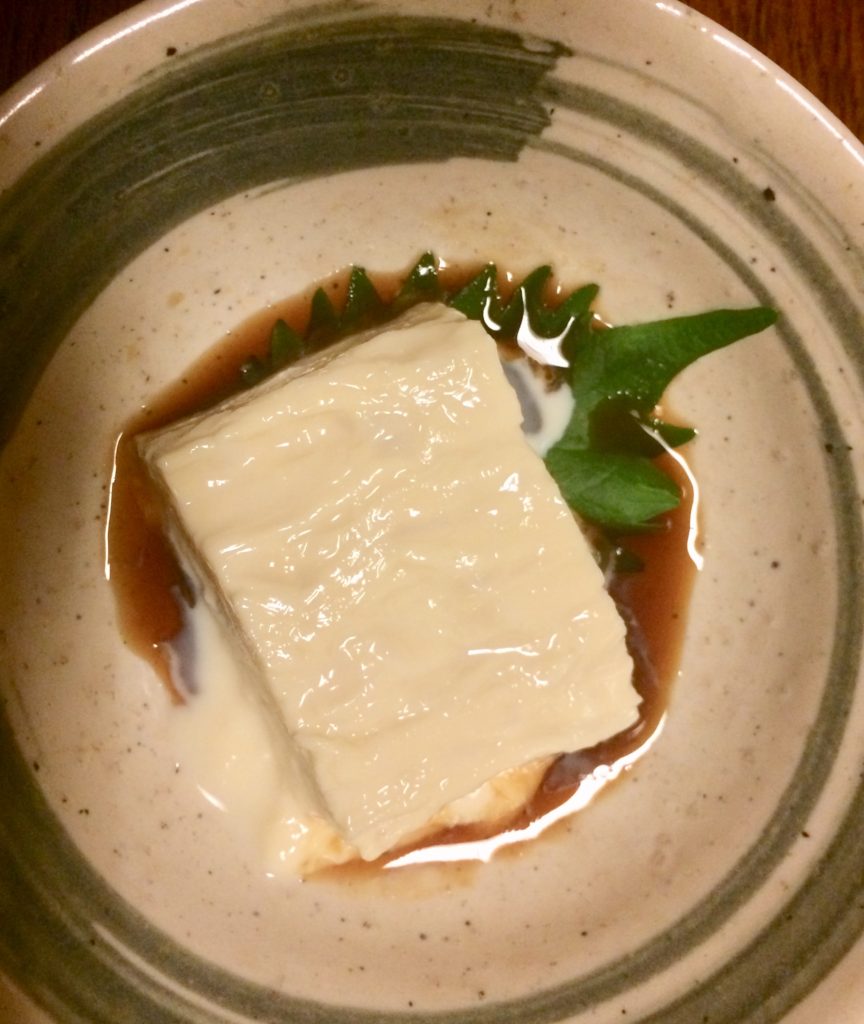
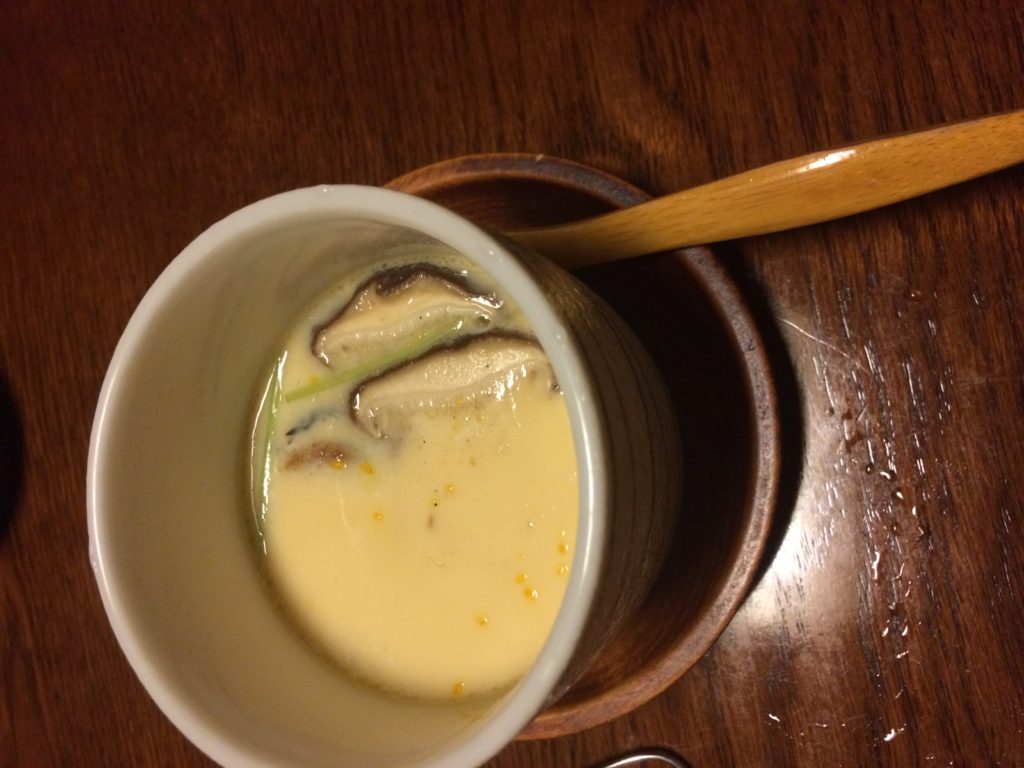
Great title, there are so many treasures in Kyoto. We only stayed for 3 days, but we’d love to go back and spend more time, it’s such a peaceful place. I loved the moss gardens, but the rock gardens were also special. I did not know that about the bath tubs. We had one in our place in Tokyo, and I thought it was such an odd, small funny thing! This post bought back so many memories for me!
Thanks Tracey, there ARE so many treasures, yes, it was hard to pick which ones to focus on for this post! I found it very peaceful too. The combination of the moss, gardens and the fact that everything is so orderly and organized makes it all rather stress free.
The deep tubs look funny, but they are wonderful to go in because of the depth and usually an abundance of steaming hot water too!
Peta
What a glorious diversion you are having. Loved learning about the kotatsu.
Ah yes, it was a glorious diversion indeed! So glad we got the opportunity to finally go to Japan together… Glad you enjoyed the kotatsu ~ such a great asset on cold days and evenings.
Peta
There’s so much in this post that I love. The photos, the descriptions and explanations of Japanese culture, the history, the art, and of course the food!
Thank you for taking me along this morning, Ben and Peta.
Deb
Deb, so glad to read that you enjoyed this post so much. Thanks for the lovely compliments.
Peta
Ben if you are hoping to increase readership with nude picture of Peta bathing let me know if it works so I can repost her picture on my blogs.
Great travel log even with clothes!
Hahaha very funny. Yup I have no clothes, but you can’t see anything, can you? You had me worried there for a hot minute. 🙂
Peta
Wow, that’s amazing! So much to experience. Although I don’t like cold, that deep bath and the kotatsu look like they might make it bearable. Peta… did you cut your hair? Maybe it was just the angle, but In that last picture of you, it looks short… did I miss a post about you getting it cut?
Janis, we almost skipped Japan because after visiting family in Chicago in winter and freezing temperatures, we were oh so ready to be back in the warmth of Viet Nam. However, I am glad we didn’t let that stop us, as it was soo worth it, even though it was cold (and not nearly as cold as Chicago, that’s for sure.)
Yes, I did chop all my hair off. I haven’t posted about it yet but it will probably be in a post soon. Quite the change from long to super short. I am done with hair dye!!
Peta
There’s nothing quite like being immersed in a Japanese bath tub. It’s so relaxing.
So very true. Something about having a tub so deep that it covers you up until your ears with steaming hot water…
Peta
Thoroughly enjoyed this trip back to Kyoto. It brought back so many memories. Like you we went up Fushimi-Inari through the bamboo forest, and rented a little machiya, though yours looks much more glamorous! That tofu meal sounds amazing!
Oh so glad you enjoyed going down memory lane with us in Kyoto. There were SO many people at Mt Inari, we were surprised, as up until then we had managed to avoid big crowds. The bamboo forest however, we had almost to ourselves…. Our home exchange was small and quite simple but had so many wonderful features, such as the tub, the kotatsu, and a dreamy could like bed.. it was great.
That tofu meal was both surprising and memorable. Who knew you could get so many different varieties of tofu, prepared in so many ways? I absolutely loved ALL the food….
Peta
I really enjoyed this post. It makes me realize how little I know about Japan and Japanese culture. Beautifully written and so many gorgeous photos to illustrate. You are rocking the short hair Peta.
Isn’t that the most glorious thing about travel ~ how much we get to learn about a different culture by being exposed to it first hand. Thank you for the lovely compliments on the photos and the text. And on my hair! (I might write a post about that sometime soon…)
Peta
Thoroughly enjoyed your Kyoto post, Peta and Ben. We had many of these experiences on our visit a year ago and it was wonderful. In addition, you share fun details like the bath and the kotatsu. Japan is full of surprises and delights, especially the food. 🙂 And your terrific photos add so much to the story.
So glad you enjoyed our Kyoto post Jane, especially having just been there recently yourself. Yes, the food was absolutely sublime and I would go back in a heart beat, if just for that! For Ben, having lived there for five years, way back, he has less interest in spending more time there… Thanks for the compliment on the photos. Coming from you, it means a lot!
Peta
So many good things here! Top choices: the Golden Pavilion reflecting, and the special tofu meal. Your new hairdo I very stylish.
Thanks Anabel. The Golden Pavilion reflecting was just gorgeous, especially with the sunlight. Apparently in summer it gets so bright it can actually hurt the eyes without sunglasses.
Thanks re the hair.. I might write about what motivated me to chop it all off.
Peta
I can to imagine why we don’t have a kotatsu in our home in Canada! It looks brilliant. I am constantly chilled through the winter and I could feel myself under the warmth of the heater and the blanket. Fascinating about the bathtub too. Can you tell I am a bit chilly while reading and am completely taken with the heating methods? we would love to return to Japan one day and I will be referring back to this post for information on Kyoto.
Sue we wondered too why the glorious invention of the kotatsu has not been exported to other countries with cold winters, much like the Japanese Toto toilet has been. It had the feeling of sitting in front of a fire, except that there is the benefit of one’s face not getting too hot!
Winter is so hard for me having lived now in tropical climates for ten years. I really struggled with it especially in Chicago where it was literally freezing cold the whole time we were there.
I would love to go back too, even if just for the food…:)
Peta
So many things in Japan have to be experienced to appreciate. Trying to describe a rock garden or looking at a photo, just can’t explain it. One must relax on the platform and take time.
What were the crowds like at the Golden Pavilion? We were there in June, and it was literally a flowing river of people. I’d like to go back in winter to see it all in a different season with fewer people.
The kotatsu is a great idea, and so Japanese. In Alaska, I always put a space heater under my desk at work, creating a dome of heat for my feat and hands.
Jeff you are absolutely correct. Especially a rock garden. One needs to experience it to understand how profoundly tranquil it is. I have anticipated seeing zen rock gardens for so long now, and it was not a disappointment.
The Golden Pavilion and the vermillion gates at Mt Inari were crowded, but no doubt not as much as in Spring and Fall and even summer, when you were there. There was mostly just a crowd right in front, where the best vantage point was for photographs, but then strangely as we walked up the path that went behind, towards the tea house, where we had a wonderful matcha tea experience, there were very few people.
Ah the kotatsu…. What an invention! Sounds like you got pretty close to the same effect, you just needed to create a tent. Would have created quite a stir at work I’m sure… Haha
Peta
I’m so intrigued by your time in Kyoto that I might have to look up flights ASAP! Given our current dilemma with the virus outbreak in China and some smaller cropping up of it in other SE Asian cities, we are tentatively beginning to look at other options … Of course, it’s unlikely I could plan a trip to Japan in a few days’ time, but all of your posts have been so appealing that we are extra eager to get there sooner rather than later.
Lex, I am SO hoping with you that you do not have to cancel your trip to SE Asia, but if you do, Japan is a wonderful choice. I think given the circumstances, yes you would do way less planning than you would usually, but if you arange accommodation for the first few days, you could no doubt book as you go. Tyoko, Nara and Kyoto, all would make for a wonderful trip. Brr, still be chilly though. Benefit of the winter is that there are WAY less tourists than in Spring and Fall when people go for the cherry blossoms and the Autumn colors. (Most of the tourist while we were there, were Asia, with a high number of Koreans.
Here is hoping that you still go on your originally planned trip and we get to host and meet you!!!!
Peta
Peta
“He has often mentioned that if any Caucasian wants to get a taste of the experience of racism in the U.S. (against blacks, Latinos, Muslims), just spend some time in Japan and see what it feels like to be shadowed in stores, and turned away in restaurants.”
A good lesson to be learned by millions, here in the US, who could use a dose of what they dish out. Not surprisingly, they most often don’t travel outside of their bubble.
Great collection of photos!
Patti, personally even though Ben had prepared me for it, I was SO surprised when we opened the door to a tiny restaurant, with four locals seated and about 4 tables empty and the hostess got very flustered by our presence and then stated that they were full. Okay, I thought, maybe she means they have reserved spaces. We ate right next door at a wonderful pub jam packed with locals from our neighborhood. After we were done, we checked in next door through the window, and lo and behold, the 4 tables were still empty!
Thank you for the compliment on the photos.
Peta
Good to see that you’re not wasting time in Kyoto, Peta 🙂 🙂 So much to see and do… and eat 🙂
Haha that’s funny Johanna. Actually we took it really slowly. Did only one thing a day and didn’t rush out of our house in the mornings and rarely went out at night. But yes, one could easily stay there a month and not tire of the sights and definitely not the food. I could eat Japanese food all year long, every day. Super healthy and super delicious. The variety was staggering!
Peta
Your posts are always so full of … everything. Food, culture, architecture, history! It’s like taking a mini-holiday to read through one of your post 😊
My favourite part was the kimono forest at the train station. I imagine it was quite the feast for the eyes.
… and like you, I think I would have opted for the walk up Mt Inari. I found the photos of the bamboo forest quite fascinating. I had no idea bamboo was considered a grass … or that it grew so large!
Thanks Joanne, that really is a terrific compliment! Glad you enjoyed your mini holiday with us.
The Kimono forest was so surprising and creative ~ definitely a fun way to jazz up a station. Bamboo is incredible. It’s also a very environmentally friendly product, as the more one cuts, the more it grows! Great substitute for cutting trees which often take decades to grow back to maturity.
Peta
Peta and Ben, Wow, on the rock gardens! The intricate placements and the philosophical meaning. All new information for me. I can (almost) feel the calm, serenity, tranquility. The North American culture would truly benefit from more areas like this. I am with you on the feet and legs warm, making a huge difference to the rest of my body staying warm. Yummy on the sushi. Cute bath photo. The hot foot bath is another thing I would appreciate. I appreciate all of the photos. I especially like the bamboo forest. I have learned and seen more about Japan in your posts than I have the last sixty years of my life. A huge thank you! You have enriched my life in more ways than you may realize.🙂
Erica/Erika, thank you for what feels like a thoughtful and meaningful accolade to the time and effort we put into Green Global Trek. What a lovely compliment!
Peta
You are welcome, Peta and Ben!
Sometimes I think people tend to overanalyze things, trying to find meaning in every little pebble or word. For Japanese gardens I think the gestalt is more important. Does it have beauty? Does it give you peace?
We have a lovely Japanese garden here in Portland. I’ve never gone there in winter, maybe I should…
Dave yes, the organized whole that is perceived as the sum of its individual parts is important. Yet, it is also the meaning that is attached to each rock and its placement as it relates to the whole.
I have read about the Japanese garden in Portland as one of our sons lives there.. perhaps we will have an opportunity to visit it. I’m sure it’s lovely in all the different seasons.
Peta
I was very excited when I read about the heat source under the table while eating a gorgeous plate of sushi, but when I got to the part about soaking in a hot footbath at the train station, I stopped reading and told Mike that we have to go to Japan! My feet are always cold. How totally civilized. Warm feet, great food and those beautiful gardens. It all sounds wonderful…except for being turned away at the restaurant even though Ben speaks Japanese (that surprised me).
Haha Caroline, that’s not a bad reason to go to Japan, you will need to go in winter though. Ah but then again there is always the onsen ( coming up in the next post) ~ the hot public baths. Ah yes Japan is very civilized.
I was surprised too at being turned away. It really boils down to foreigners not “ acting “ culturally appropriately”. Common missteps are staying too long/ lingering in a place like a noodle shop which relies on a large turnover. Or not taking shoes off, or speaking too loudly. All these types of things can ruin the carefully crafted ambience for the other diners.
Peta
This brings back a lot of great memories from my trip to Kyoto in October 2016. Nijo-jo was such a beautiful and elegant castle, Kinkaku-ji a testament to Japanese finesse, and Fushimi Inari-taisha a fascinating place despite the tourist crowd. I’m surprised that even though Ben speaks Japanese, he was turned away at that restaurant. One would think if a foreigner understands the local language, he/she must be more aware of the local customs and etiquette than other tourists. But I’m glad you met that taxi driver. In Kyoto, James and I went to this small restaurant which was clearly geared toward the locals for the absence of English signboard outside. Inside, it was eerily quiet although there were a few other customers. Our cameras’ shutters made the loudest sound, but I’m glad we were not told to leave the restaurant!
Bama I was surprised too, thinking that knowledge of the language would surely serve to elevate the perception of us as not being clueless tourists. But in some cases a foreigner is seen as a foreigner, who is sure to have some missteps and inappropriate behavior just by fact of not being Japanese. Nonetheless as a Caucasian I think it’s actually a good experience so as to fully understand what it feels like. I think once you make it inside, you have been accepted. Having experienced that quiet atmosphere, one can only imagine how jarring and out of place loud Americans has an example) would be,
Peta
I appreciate this beautiful visit to Kyoto, Peta, and enjoyed the photos and narrative. You do a great job of integrating many of the cultural aspects and giving us a feel for this famous city and environs. Food, weather, customs, locals, temples. Thank you.
Thanks Jet for the really flattering comments. For us, the cultural aspects encompasses not just the sights, or the food (although that is a big part for us), but also any tidbits we can observe about local customs, the politics and items in the news that gives us a deeper understanding of the culture.
Peta
Your post stirred some wonderful memories of Kyoto. We absolutely loved Kyoto with its zen gardens (your first picture) and peaceful bamboo grove (Arashayima). We did miss a lot though and your pictures took me there. Your smile is lovely, Peta! Keep Smiling!
Thanks Cheryl. I think if one spent a month in Kyoto then maybe one could begin to have an idea of most of what it has to offer. Pleased that our post brought back good memories and took you back for a short while.
Peta
Thanks Cheryl. I think if one spent a month in Kyoto then maybe one could begin to have an idea of most of what it has to offer. Pleased that our post brought back good memories and took you back for a short while.
Peta
Such an inspiring article. My biggest dream is to visit Japan. Kyoto looks amazing. Have to organize a trip!
Thank you. Glad to have inspired you with our post. Hope you get to enjoy a trip there.
Peta
Thanks for introducing me to a kotatsu! I think I need that here in Knoxville, TN on cold, winter days! And thanks, too, for the lovely photos of the zen gardens. So lovely.
Rusha you do need one! Interesting that Japanese Toto toilets have been exported to the U.S. with great success, but not kotatsu…yet!
Ahhh those zen gardens. Nothing quite like the peace and tranquility that they exude.
Peta
I am having fun travelling along with you here. The fabulous tofu dishes are making me hungry!
Glad you are enjoying our posts on Japan, Darlene. The tofu dishes were so surprising ~ such unique flavours and different consistencies.
Peta
I’ve always appreciated the minimalism of Japanese decor. It gives me an instant sense of tranquility. Even the food presentation is simple and harmonious. What a delightful visit you both had, despite being turned away from restaurants.
The minimalist and mindful approach to decor and to food presentation is so unique to Japan and it does creates a feeling of calm and harmony, for sure
I found it interesting to be turned away from a few restaurants, because I appreciate an understanding as a Caucasian, of what it must feel like for those of colour having a similar experience, no matter where that might happen. Twenty years ago when Ben lived in Japan, he said it happened with way more frequency than today… And I do think it has more to do with their fear of foreigners not behaving culturally appropriately than with racism per se, but the end feeling one has is that of being excluded based on ones nationality or skin color.
Peta
I’ve been to this post 4 times now, decided it was time to say something. So let me begin with WOW! I know that breaks the essence of serenity and internal reflection that this was meant to inspire. I can’t mention everything you’ve written about here, because there’s no need to try to say in words what you’ve already done, and with lovely photos to support them. But one thing I noticed is how the built features, especially the temples by water, sit quietly and encourage repose. They complement the bamboo forests and the paths that take you to the top of the mountain. The vermillion gates are dominating and I’d love to know what the prayers say. My favorite part of this post, so hard to choose, are those gorgeous murals in the castle and the humble potter with his lovely wares. How did Ben manage to choose just one cup?
Yes, Sharon, every single temple encourages repose and leaves one feeling serene. The Japanese are masters at incorporating nature and architecture and landscaping. Everything so thoughtful and meaningful.
Interestingly, the words on the vermillion gates are not prayers, they are the names of the donors who gave money for the gates to be built ~ by doing this the donors hope to receive ongoing good luck and good fortune.
We spent so much time at the potter. Ben talking to him and both of us appreciating his creative work and skill. We were on our way from six weeks in the States and our cases were pretty full. We were carrying by hand two beautiful pieces of ceramics that our youngest son made and had gifted to us. So we had limited space and of course ceramics being super fragile… that said, we should have got a pair of cups while we were at it. We are also super thoughtful about accumulating stuff, as we strive for minimalism.
Peta
The gardens and architecture reveal such a beautiful, harmonious aesthetic. I am really drawn to it — so pleasing to the eye and peaceful. I used to enjoy visiting the Nikka Yuko Japanese garden in Lethbridge, Alberta, and also the Nitobe Memorial Garden in Vancouver. Nikka Yuko has many of the elements shown in your photos — rock garden with viewing platform, reflecting ponds with rocks, winding pathways, beautiful trees arranged to create sight lines with interesting colours and forms.
Thanks for sharing this Kyoto experience on your blog.
Jude
Thanks Jude, it is nice to be reminded that the Japanese Zen garden aesthetic has been recreated in gardens all over the world. We have visited the one in Chicago at the Botanic Gardens, which was near where we used to live in the U.S. Someone else mentioned that there is a beautiful one in Portland Oregon as well.
Thanks for stopping by to read us and to leave us your contribution.
Peta
I loved the moss gardens, but the rock gardens were also special. I did not know that about the bath tubs. We had one in our place in Tokyo, and I thought it was such an odd, small funny thing! This post bought back so many memories for me!
Such a inspiring article.
Thanks for sharing this Kyoto experience on your blog.
Interesting to see what it was like in winter or late fall. We went there when summer was going to start. Sunny and humid.